Summer is the perfect time to observe the diverse species of birds that populate our skies. With the warm sunshine and long days, we are treated to a symphony of Avian melodies that provide the perfect backdrop for this season.
From the twittering of finches to the soaring of eagles, there is no shortage of birds to admire in the summer months.
Whether you are a casual watcher or a seasoned birder, there is something fascinating and awe-inspiring about these feathered creatures’ intricate behaviors and abilities.
In this article, we will explore the many aspects of birds in summer, including their nesting habits, feeding behaviors, and migration patterns.
1. Black Kite
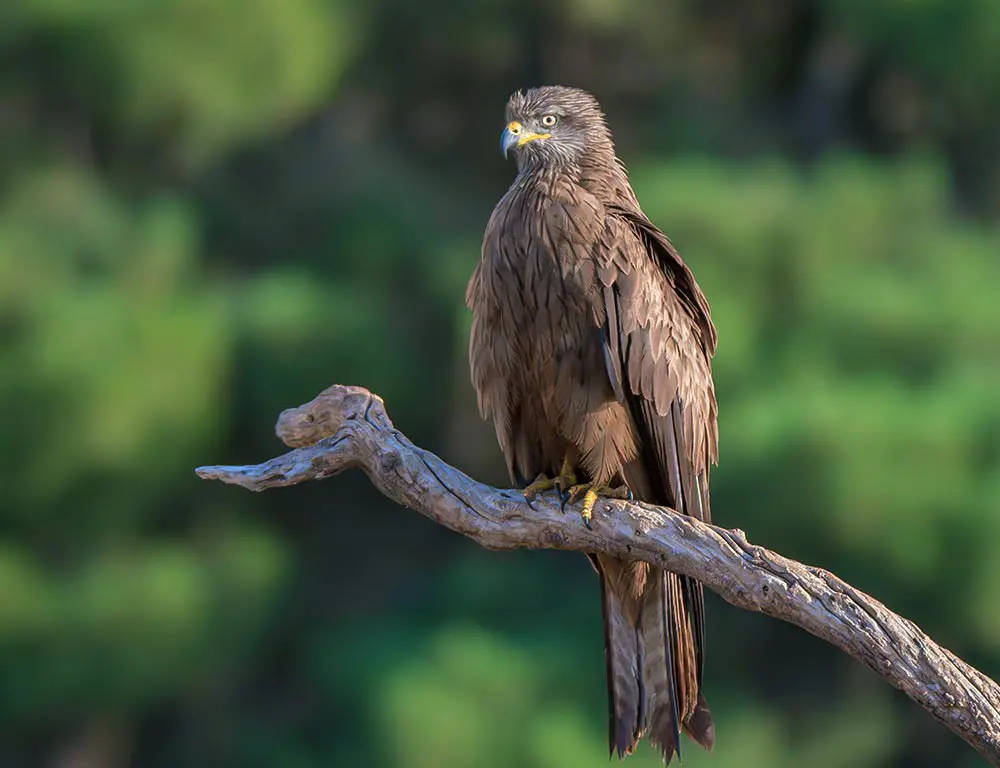
The black kite is one of the most abundant species of diurnal birds of prey in the world, with a global population estimated to be up to 6 million individuals.
It belongs to the family Accipitridae and has medium-sized body size. The wingspan can range from 150 cm – 180cm wide.
They have dark brown feathers on their back, light brown or grey underparts, and long forked tails that help them maneuver through.
Its environment includes hunting for food like insects, small mammals, reptiles, etc., and scavenging opportunities when available.
Black Kites are found across several continents, including Europe, Africa, Asia Minor & Australia, where they breed during spring in nests made among trees near wetlands or riversides;
migratory populations move southward away from winter cold temperatures as far east as India & Japan before returning home again next season.
Scientific classification:
| Kingdom | Animalia |
| Phylum | Chordata |
| Class | Aves |
| Order | Accipitriformes |
| Family | Accipitridae |
| Genus | Milvus |
| Species | M. migrans |
Also Featured In: Common Birds in India, Common Birds in the Cities
2. Northern Cardinal
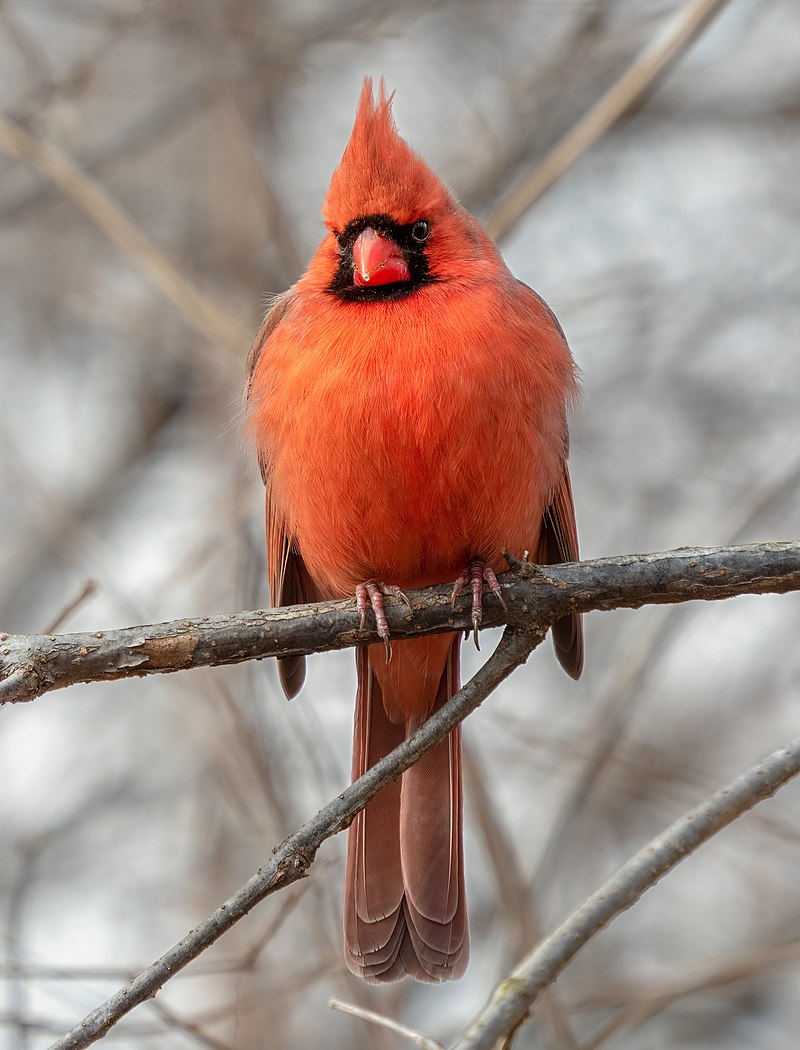
The Northern Cardinal is a beautiful bird, easily identified by its bright red plumage. It can be found in the eastern United States from Maine to Minnesota and south through Mexico and Belize.
Along with its striking coloration, it has a distinctive crest on its head and sharp black facial markings around the eyes.
Despite their small size (measuring 7-9 inches), they are very vocal birds – males sing persistently throughout springtime to attract mates or proclaim their territory.
They typically feed on insects, seeds, and fruits but also enjoy suet at backyard bird feeders.
The female is less brightly colored than her mate but still stands out among other songbirds due to her warm brownish-red feathers.
Cardinals pair for life, so you may often see them together in your garden or neighborhood park.
Scientific classification:
| Kingdom | Animalia |
| Phylum | Chordata |
| Class | Aves |
| Order | Passeriformes |
| Family | Cardinalidae |
| Genus | Cardinalis |
| Species | C. cardinalis |
Also Featured In: Most Common United States Birds, Birds for Your Home Garden
3. American Robin

The American robin is a migratory bird belonging to the true thrush genus and Turdidae family.
It was named after its European counterpart due to the similar reddish-orange breast they possess; however, they are not closely related.
This species can be seen through most of North America during winter months and in parts of Mexico and Central America, where it also breeds.
They have plump bodies with gray upperparts and white underparts that vary from yellow on their throats down to orange toward their bellies.
Robins feed on fruits such as berries or insects like worms, making them an important part of ecosystems by helping disperse seeds naturally throughout these areas.
Scientific classification:
| Kingdom | Animalia |
| Phylum | Chordata |
| Class | Aves |
| Order | Passeriformes |
| Family | Turdidae |
| Genus | Turdus |
| Species | T. migratorius |
Also Featured In: Most Common Winter Birds, Birds that Calls in the Morning
4. American Goldfinch
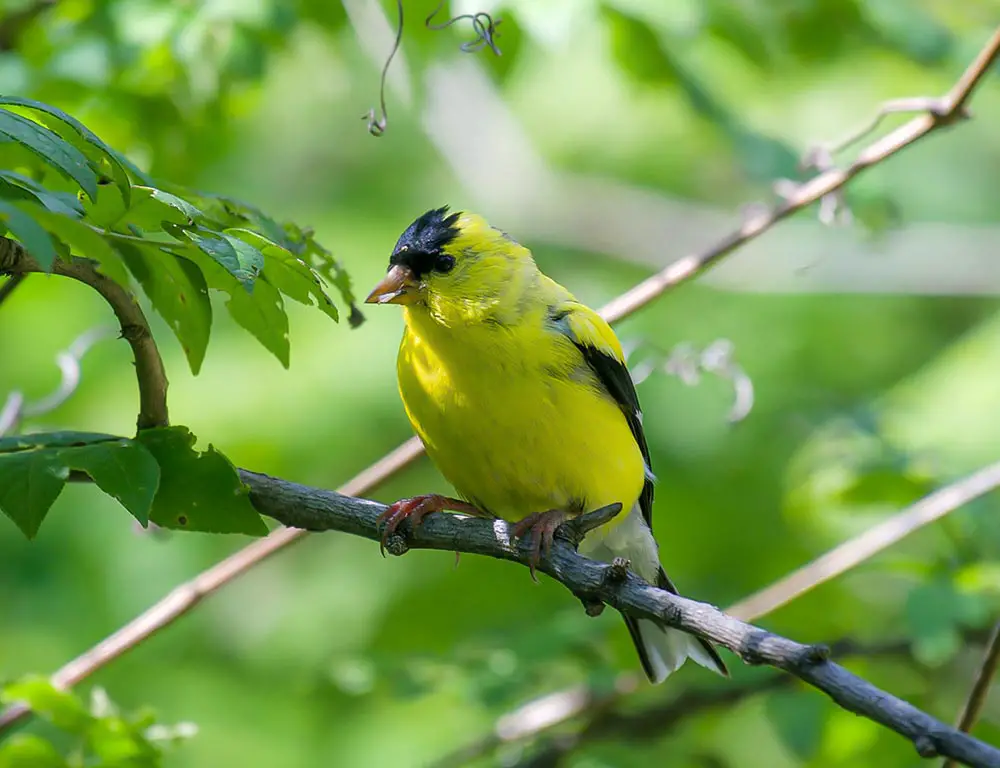
The American goldfinch is a small North American bird in the finch family. Males are vibrant yellow with black wings and tails, while females are duller in coloration.
It migrates from mid-Alberta to North Carolina during the breeding season, south of Canada–United States border to Mexico for its wintering grounds.
The only finch that undergoes complete molt every year displays sexual dichromatism, where males have brighter colors than their female counterparts.
They feed mainly on seeds but also eat insects such as aphids and caterpillars when raising young; they often occur near thistles or other plants that produce viable seed heads.
Their call consists of various chirps and trills, making them quite conspicuous.
Scientific classification:
| Kingdom | Animalia |
| Phylum | Chordata |
| Class | Aves |
| Order | Passeriformes |
| Family | Fringillidae |
| Subfamily | Carduelinae |
| Genus | Spinus |
| Species | S. tristis |
Also Featured In: Common Central Park Birds, Most Common Nature Birds
5. Songbirds
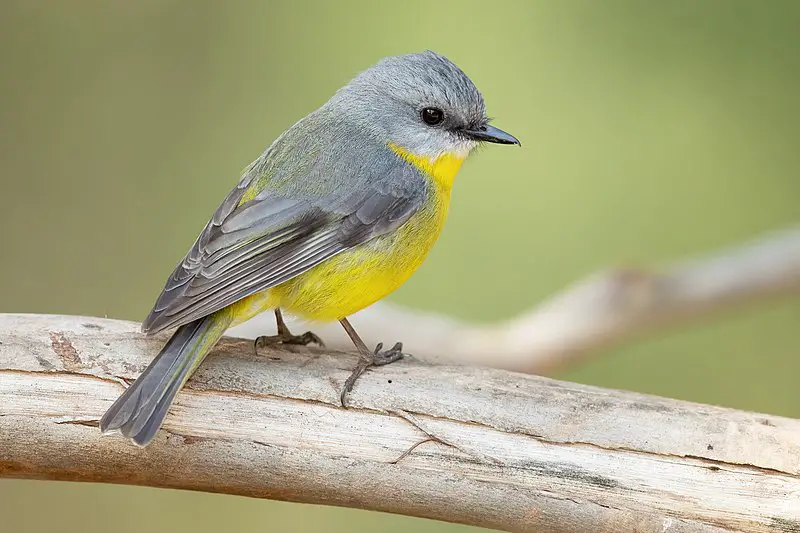
Songbirds are a special suborder of perching birds found all over the world. These beautiful creatures have intricate vocal organs that allow them to produce elaborate bird songs, making them stand out from other species.
With around 5,000 different types of songbirds in existence, they come in various sizes and colors, with complex feathers adding to their beauty.
Songbirds play an important role in ecosystems as they help disperse seeds by eating fruit and insects, which act as agents for pollination.
Their presence also attracts more biodiversity into areas where these delicate animals live, creating vibrant habitats full of life.
Scientific classification:
| Kingdom | Animalia |
| Phylum | Chordata |
| Class | Aves |
| Order | Passeriformes |
| Clade | Eupasseres |
| Suborder | Passeri Linnaeus, 1758 |
Also Featured In: Famous Paintings Birds, Most Common Lake Birds
6. Western Meadowlark
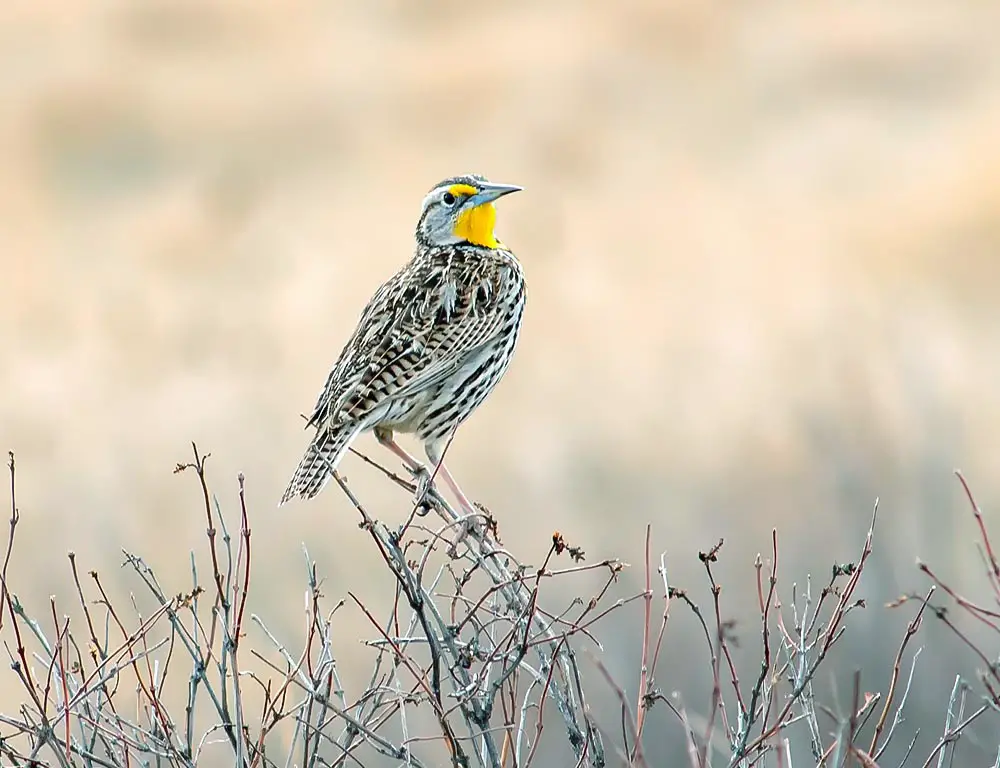
The western meadowlark is a medium-sized icterid bird native to North America. It has a distinct yellow breast with black and white patches, making it easy to spot in open grasslands.
Its diet consists mostly of bugs but also includes seeds and berries. The western meadowlark’s call is unique – its sound is flute-like or watery, differentiating it from the similar eastern meadowlark species.
When the nesting season arrives, they build their nests on the ground near shrubs or low trees in areas like fields and pastures.
This beautiful songbird adds life to our open lands with its melodious tunes.
Scientific classification:
| Kingdom | Animalia |
| Phylum | Chordata |
| Class | Aves |
| Order | Passeriformes |
| Family | Icteridae |
| Genus | Sturnella |
| Species | S. neglecta |
Also Featured In: Birds that Live in the Grasslands, Birds in Iowa Spring
7. Black-Capped Chickadee
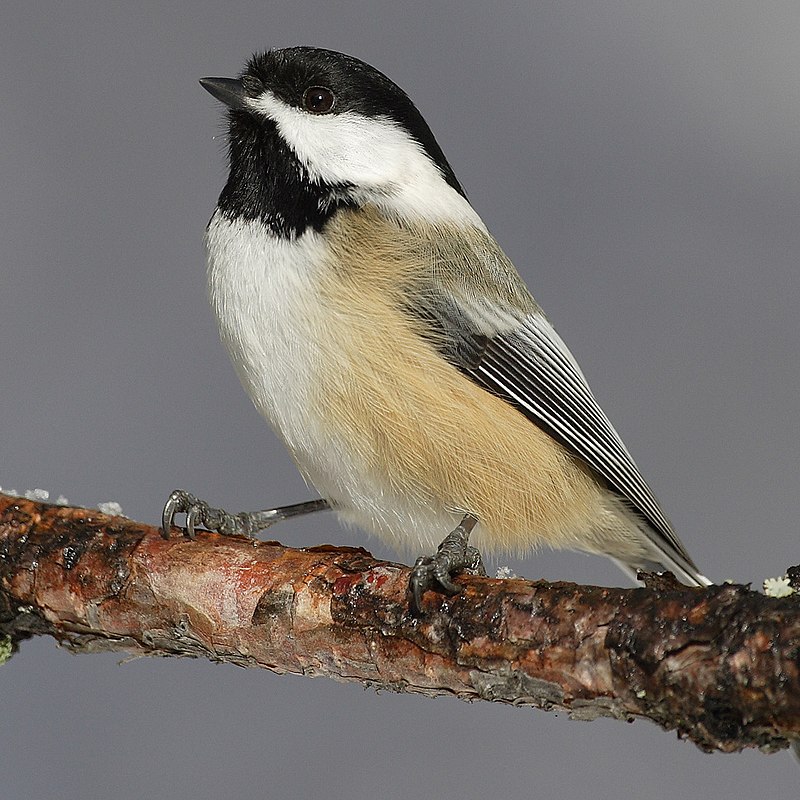
The black-capped chickadee is a small, cheerful songbird in deciduous and mixed forests across North America. It has an iconic black cap, white cheeks, gray back, and wings with whitish bars on them.
The underparts are usually light-colored or greyish-brown. This species is well adapted to cold winters as it can reduce its body temperature by up to 8°C while roosting at night; this helps save energy during the year’s colder months.
It feeds mainly on insects but also eats seeds, fruits, and suet from bird feeders when available.
Black-capped chickadees are popular birds among backyard visitors due to their sociable nature – they often establish lifelong partnerships with one another for breeding purposes.
Furthermore, they have been designated as state birds of Massachusetts and Maine in the USA and New Brunswick in Canada – a testament to how beloved these little avian friends are.
Scientific classification:
| Kingdom | Animalia |
| Phylum | Chordata |
| Class | Aves |
| Order | Passeriformes |
| Family | Paridae |
| Genus | Poecile |
| Species | P. atricapillus |
Also Featured In: Autumn Birds You Should Know, British Columbian Birds
8. Mountain Bluebird
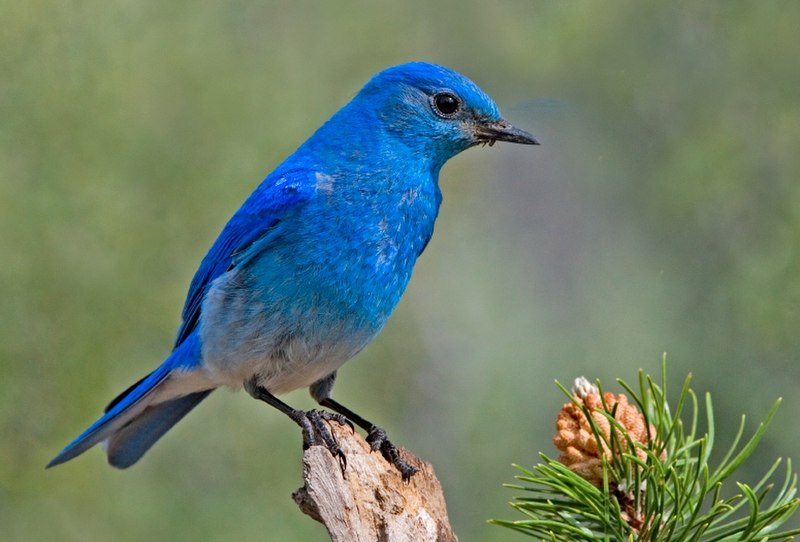
The Mountain Bluebird is a beautiful sight to behold. It has bright turquoise-blue wings and tail, with a light underbelly, grey crown and breast, black eyes, and thin bills.
During the fall season, its plumage changes slightly – females have duller blue wings and tails and grey throats and backs.
As they migrate across western North America during springtime, these birds can be found in mountainous districts where they feed on insects such as grasshoppers or crickets collected from meadows or fields of grain.
They also enjoy eating berries when available. Through their stunning colors, this species adds vibrancy to any landscape it traverses through – truly an incredible creature of nature.
Scientific classification:
| Kingdom | Animalia |
| Phylum | Chordata |
| Class | Aves |
| Order | Passeriformes |
| Family | Turdidae |
| Genus | Sialia |
| Species | S. currucoides |
Also Featured In: Birds Commonly Found in Northern California, Birds that Found in the Yellowstone
9. Eastern Bluebird
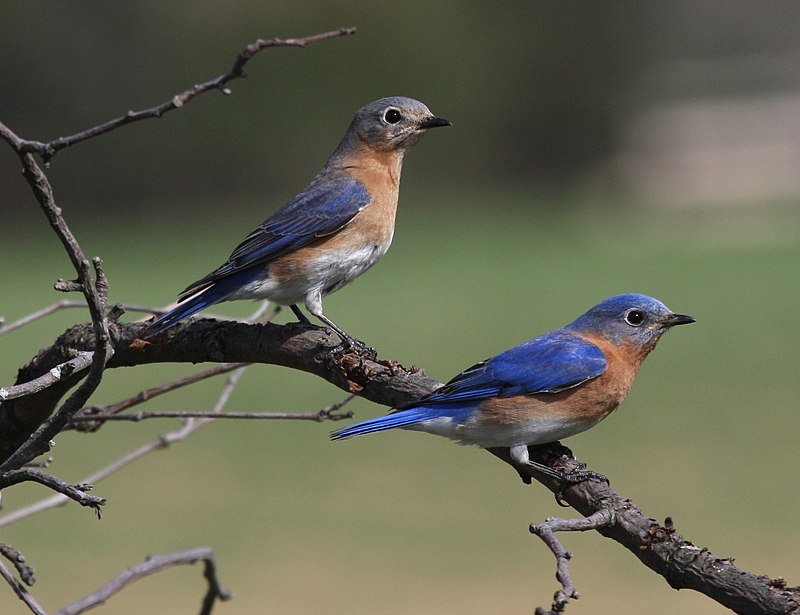
The Eastern bluebird is a small migratory thrush that can be found in open woodlands, farms, and orchards across North America.
The male has bright-blue breeding plumage, which makes it easily recognizable by birders.
It produces melodious songs such as jeew, chir-wi, and chiti WEEW wewidoo.
This popular species was declared the state bird of Missouri back in 1927 due to its beauty and charm.
In addition to being beautiful, these birds are also beneficial for farmers because they eat insects like grasshoppers and beetles, which damage crops.
They nest in cavities, so providing nesting boxes helps them thrive even more.
With their vibrant colors, sweet melodies, and helpful nature, it’s easy to see why the Eastern Bluebird is beloved worldwide.
Scientific classification:
| Kingdom | Animalia |
| Phylum | Chordata |
| Class | Aves |
| Order | Passeriformes |
| Family | Turdidae |
| Genus | Sialia |
| Species | S. sialis |
Also Featured In: House Birds You’ll Love to Pet, Birds that Migrate through Illinois in the Spring
10. Baltimore Oriole
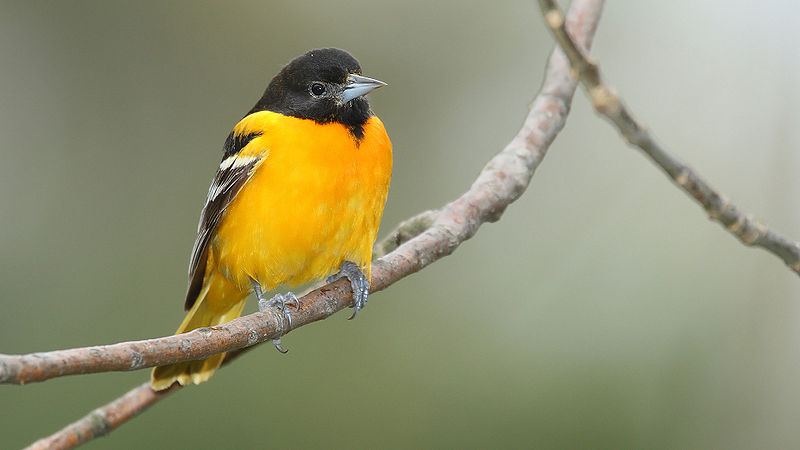
The Baltimore Oriole is a small, blackbird-like bird found in eastern North America. It’s named for the resemblance of its male colors to those on Lord Baltimore’s coat-of-arms from the 17th century.
These birds migrate and breed during springtime and are quite common in their habitats.
Studies have shown that this species interbreeds with western Bullock’s orioles, classifying both as a single species – Icterus galbula.
The males typically have orange feathers along the chest, back, wings, and tail, while females display tan or yellowish shades instead of bright orange-like males.
Both sexes share white wing bars and dark brown eyes, making them easily distinguishable from other birds.
They can often be seen flitting around trees, feeding off nectar buds or insects such as grasshoppers & caterpillars they catch while flying around.
Scientific classification:
| Kingdom | Animalia |
| Phylum | Chordata |
| Class | Aves |
| Order | Passeriformes |
| Family | Icteridae |
| Genus | Icterus |
| Species | I. galbula |
Also Featured In: Common Birds in Alberta, Birds that Live in Mississippi
11. Common Loon
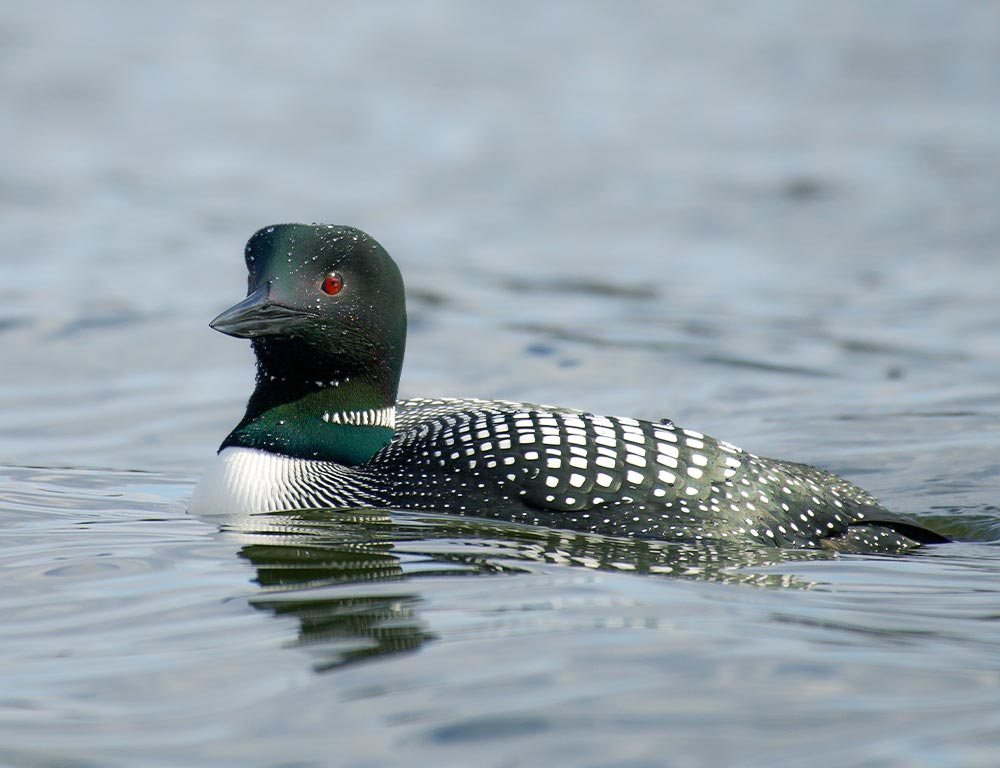
The Common Loon is a beautiful bird found in North America. It has a large black head and neck, with a greenish to purple sheen that stands out against its dark grey upperparts.
The underparts are pure white except for some black on the undertail cover and vent.
During the non-breeding season, adults have brown plumage instead of the bright shades they show during the breeding season.
They also exhibit unique behaviors, such as diving underwater to catch fish or swimming along lakeshores while calling loudly, which is how they got their name “great northern diver.”
With their stunning colors and interesting behavior, it’s no wonder why these birds make up an iconic part of many landscapes across North America.
Scientific classification:
| Kingdom | Animalia |
| Phylum | Chordata |
| Class | Aves |
| Order | Gaviiformes |
| Family | Gaviidae |
| Genus | Gavia |
| Species | G. immer |
Also Featured In: Water Birds Live around Us, Shetland Islands Birds You Should Know
12. Blue Jay
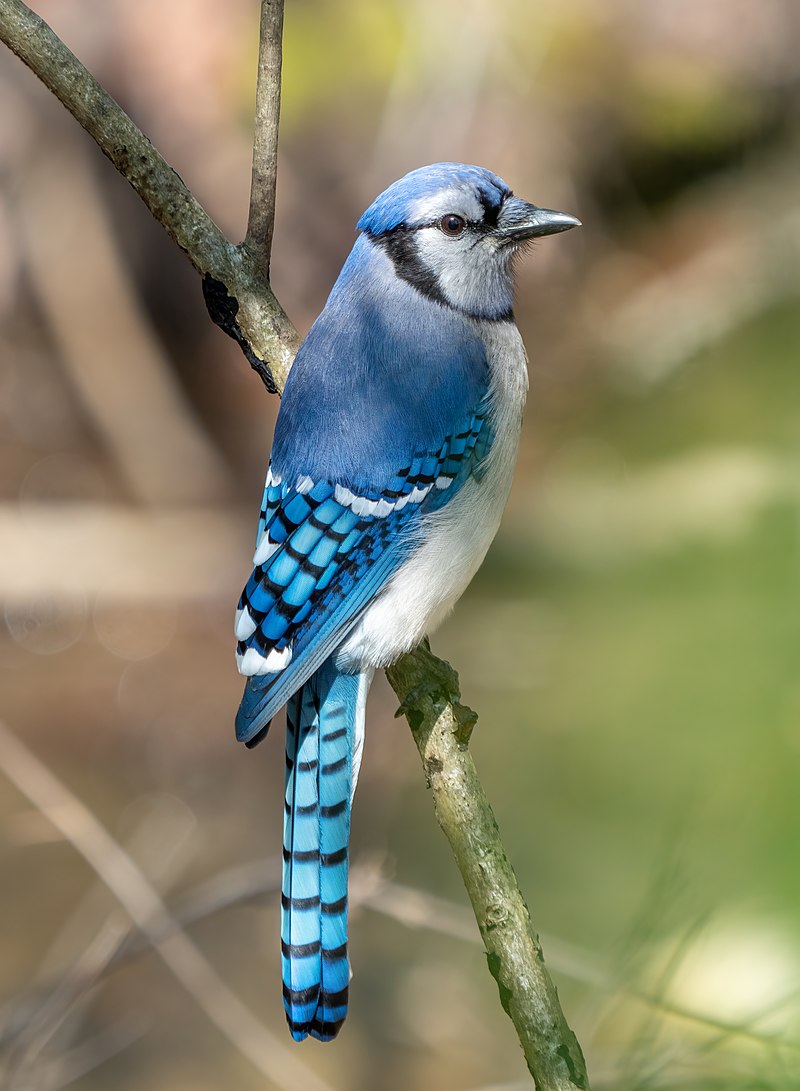
The Blue Jay is a beautiful bird residing in the eastern and central United States and Newfoundland, Canada.
They have an unmistakable blue colored plumage with white markings on their heads and wings.
These birds are highly adaptable to different habitats ranging from deciduous forests to urban areas.
As part of the Corvidae family, they are known for being intelligent problem solvers who will often use tools or mimic vocalizations of other species, like hawks, when defending their territories.
Their diet consists mostly of insects, seeds, and nuts but can also include small vertebrates such as frogs or lizards if food resources become scarce.
Overall, these birds provide much-needed color to our environment while playing important roles in maintaining healthy ecosystems through pollination services and seed dispersal activities.
Scientific classification:
| Kingdom | Animalia |
| Phylum | Chordata |
| Class | Aves |
| Order | Passeriformes |
| Family | Corvidae |
| Genus | Cyanocitta |
| Species | C. cristata |
Also Featured In: Birds of Nova Scotia, Birds of Symbolism
13. Wood Thrush
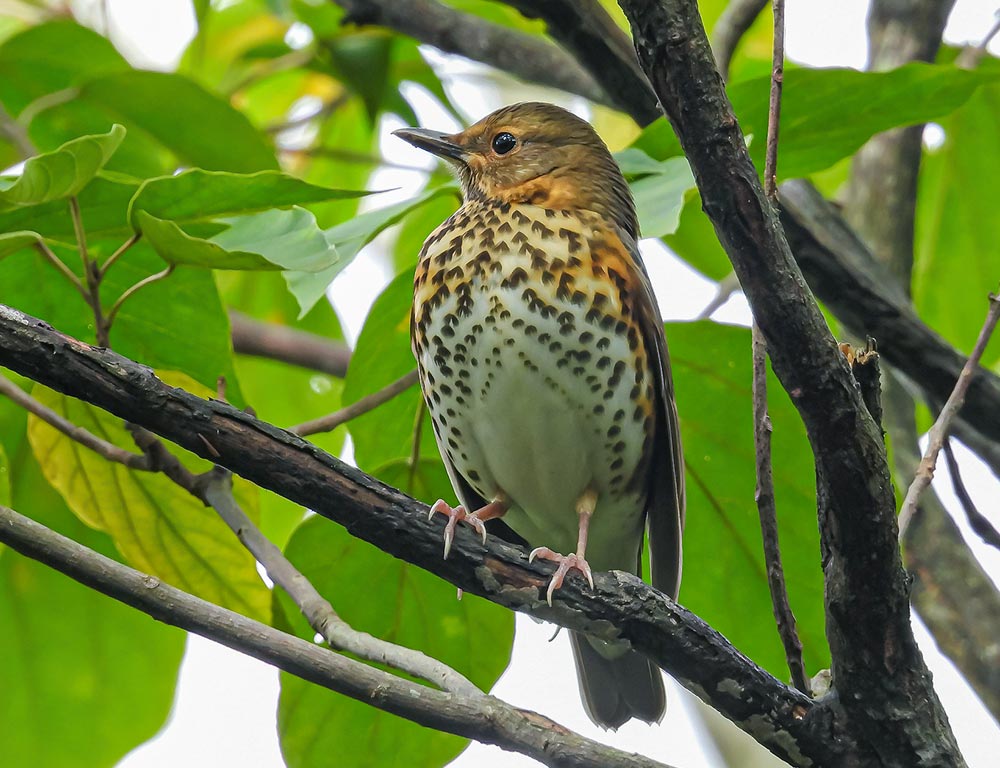
The Wood Thrush is a beautiful bird native to North America, closely related to the American Robin.
It has mottled brown and white upperparts with a spotted breast, buffy sides and flanks, and reddish-brown tail feathers.
This medium-sized thrush prefers wooded areas where it can find its favorite food – insects such as beetles, caterpillars, and spiders.
The male’s song is one of the most recognizable sounds in nature, an ethereal mix of flute-like whistles that often echo through forests on warm summer nights.
The Wood Thrush holds special status as the official bird of Washington D.C., making it even more beloved amongst local residents who take pride in seeing this exquisite species up close.
Scientific classification:
| Kingdom | Animalia |
| Phylum | Chordata |
| Class | Aves |
| Order | Passeriformes |
| Family | Turdidae |
| Genus | Hylocichla Baird, 1864 |
| Species | H. mustelina |
Also Featured In: Brown Tennessee Birds, Brown Birds of Florida
14. Downy Woodpecker
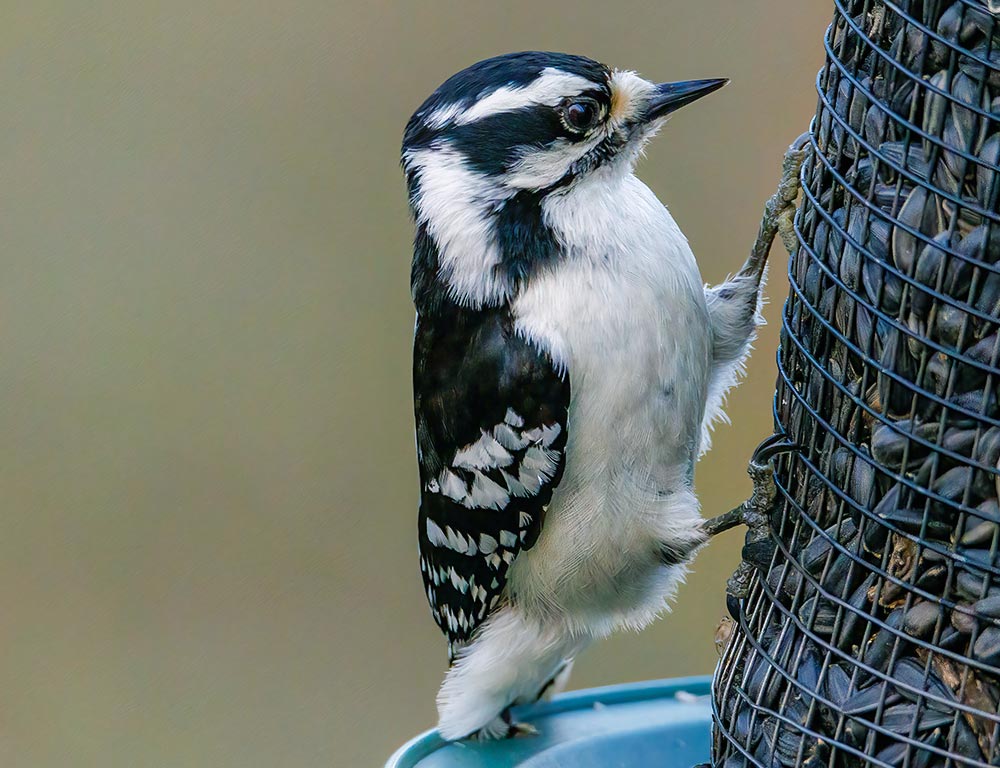
The downy woodpecker is a small species of woodpecker found in North America. Growing up to 7 inches long, it can be identified by its white belly and spotted wings.
It inhabits forests throughout the United States and Canada, with the exception of deserts in the southwest and northern tundra.
This bird nests in tree cavities and feeds mostly on insects but will supplement its diet with fruit or nuts when available.
The Downy Woodpecker has an unmistakable call that sounds like a loud ‘piker,’ similar to other members of its family, such as the Hairy Woodpecker.
Scientific classification:
| Kingdom | Animalia |
| Phylum | Chordata |
| Class | Aves |
| Order | Piciformes |
| Family | Picidae |
| Genus | Dryobates |
| Species | D. pubescens |
Also Featured In: Birds in Calgary You’ll Love to See, Birds in Pacific Northwest
15. House Finch

The House Finch is a species of finch native to western North America and has been introduced in the eastern half of the continent and Hawaii.
It’s an average-sized finch with adults measuring 12.5 – 15 cm (5 – 6 inches) long and wingspan between 20 – 25 cm (8 – 10 inches).
The upperparts are brown, while its underparts range from pale grayish white to yellow depending on subspecies.
Its face is streaked or spotted with reddish coloration; males typically have brighter plumage than females due to sexual dimorphism.
They’re mostly found near human habitations such as farms and gardens, where they feed on grains, fruits, insects, etc., making them very popular among birders who want something colorful for their backyard.
Scientific classification:
| Kingdom | Animalia |
| Phylum | Chordata |
| Class | Aves |
| Order | Passeriformes |
| Family | Fringillidae |
| Subfamily | Carduelinae |
| Genus | Haemorhous |
| Species | H. mexicanus |
Also Featured In: Common Birds That Live in Las Vegas, Birds That Live around Seattle
16. Common Starling

The Common Starling is a medium-sized passerine bird that belongs to the Starling family. It has glossy black plumage with a metallic sheen; at certain times of the year, it can be speckled with white.
The bill and legs are typically pink or black depending on the season, while its length measures about 8 inches long. Its diet consists mainly of insects but includes small fruits, seeds, and human food waste.
They live in large flocks, which provides protection against predators, although they can become quite aggressive when defending their nesting sites during breeding seasons.
Overall, this species is highly adaptable and widely distributed across many parts of Europe, making them one of the most successful birds in the region today.
Scientific classification:
| Kingdom | Animalia |
| Phylum | Chordata |
| Class | Aves |
| Order | Passeriformes |
| Family | Sturnidae |
| Genus | Sturnus |
| Species | S. vulgaris |
Also Featured In: Ukrainian Birds You Should Know, European Birds
17. Mourning Dove
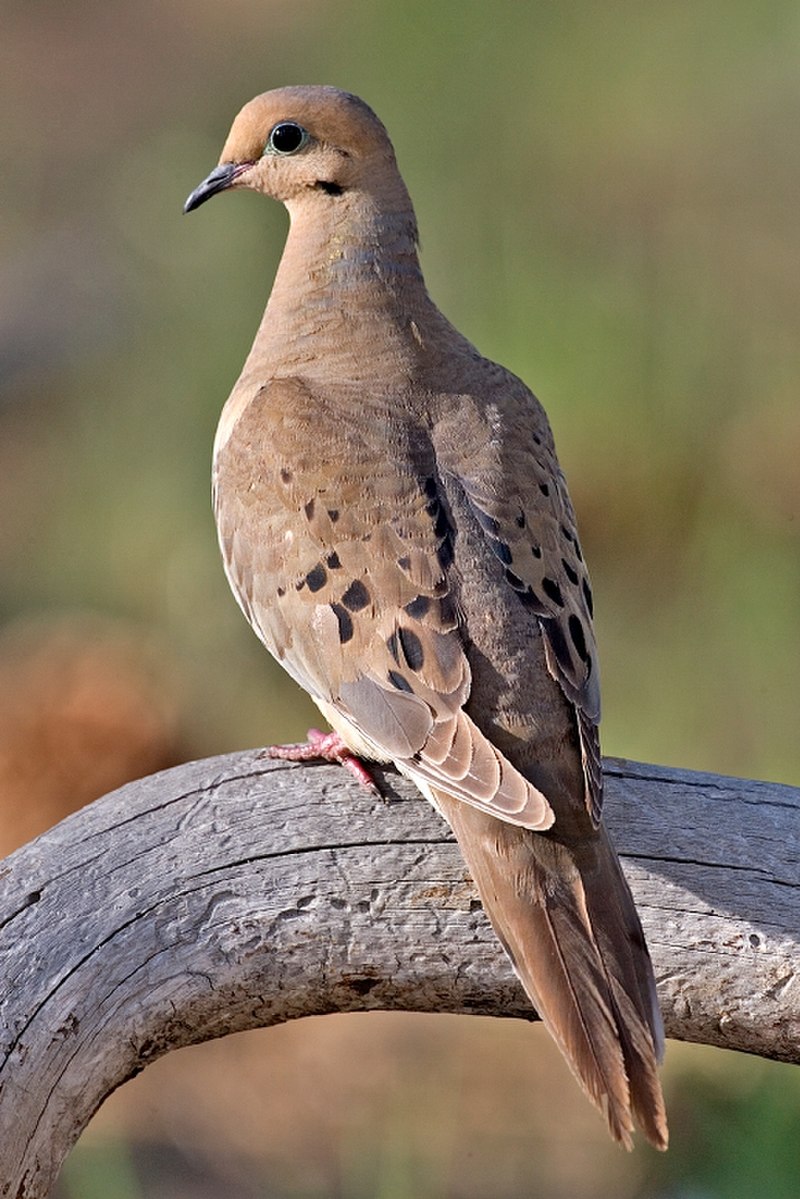
The Mourning Dove is a breathtakingly beautiful bird. It has stunning gray and brown feathers with white-tipped wings, giving it an elegant appearance. Its long tail also adds to its graceful look in flight.
A symbol of peace and serenity, they are abundant across North America and can be found in gardens or open fields throughout the year.
As well as being popular game birds for hunters, they feed on grains such as wheat and millet, providing important food sources for wildlife species, including foxes, coyotes, skunks, and raccoons.
These doves have a distinctive cooing sound that can often echo through woodlands during summer evenings, making them one of nature’s greatest treasures.
Scientific classification:
| Kingdom | Animalia |
| Phylum | Chordata |
| Class | Aves |
| Order | Columbiformes |
| Family | Columbidae |
| Genus | Zenaida |
| Species | Z. macroura |
Also Featured In: Birds that Live in San Francisco Bay Area, Common Species of Birds
18. White-Breasted Nuthatch
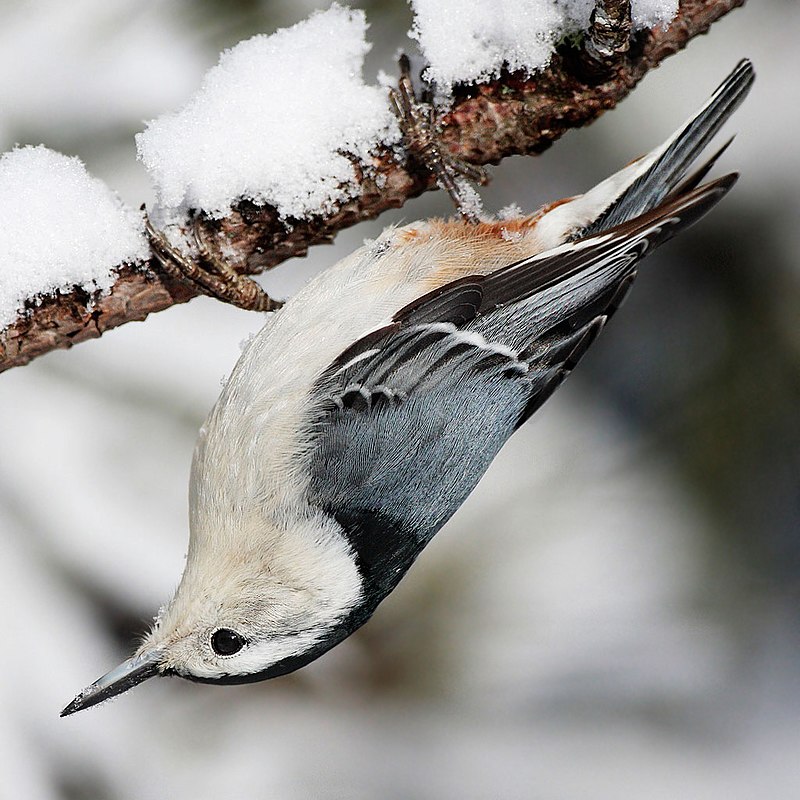
The White-breasted Nuthatch is a medium-sized bird belonging to the nuthatch family Sittidae. It measures around 15.5 cm long, and its color varies throughout its range.
Males have a light blue-grey upperpart, with a black crown and nape, whereas females have a dark grey crown instead of a black one.
The underparts are whitish, with reddish tinge on sides and flanks while the bill is short and stout with pale base near eyes which can be yellow or white depending upon geographic location..
This species feeds mainly on insects but will also eat seeds, nuts, and berries when available.
They prefer open woodlands where they often climb trees searching for food along trunks and branches underneath bark crevices, creating their nest there, too.
Scientific classification:
| Kingdom | Animalia |
| Phylum | Chordata |
| Class | Aves |
| Order | Passeriformes |
| Family | Sittidae |
| Genus | Sitta |
| Species | S. carolinensis |
Also Featured In: Small Kentucky Birds, Large Birds Live in Idaho
19. Red-Winged Blackbird

The red-winged blackbird is a beautiful bird found in most of North America and Central America.
Its distinct features include a glossy black body, with white shoulder patches and bright red wing coverts year round.
It prefers wetland habitats such as marshes, ponds, lakeshores, and agricultural fields. During breeding season, they inhabit grassy areas near water, then move south for the winter months.
For food, they mainly eat insects but also consume wild fruit or grains.
They are very social birds, often seen in large flocks during migration times when their unmistakable “conk-la-ree” call can be heard echoing across the sky.
Scientific classification:
| Kingdom | Animalia |
| Phylum | Chordata |
| Class | Aves |
| Order | Passeriformes |
| Family | Icteridae |
| Genus | Agelaius |
| Species | A. phoeniceus |
Also Featured In: Wetlands Birds You Should Know, Birds that Live in Vancouver
20. Barn Swallow
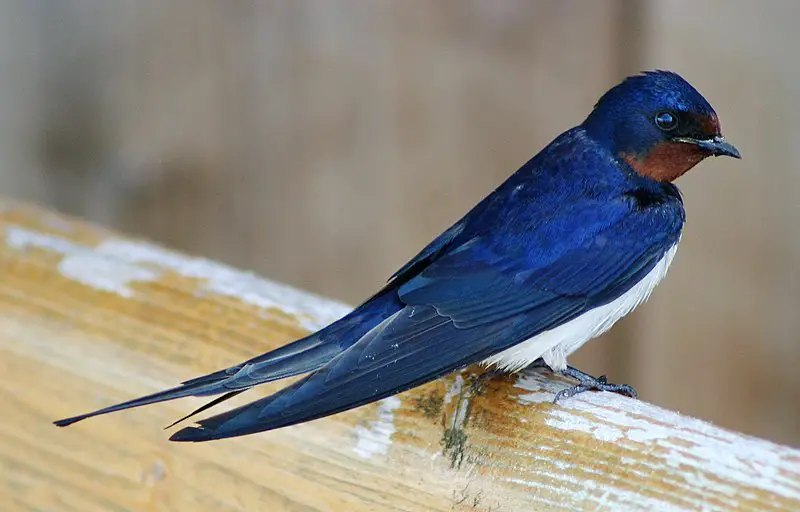
The Barn Swallow is a beautiful passerine bird with blue upperparts and a long, deeply forked tail. Found in Europe, Asia, Africa and the Americas.
It has an astonishingly large natural distribution spanning 251 million square kilometers globally, likely making it one of the world’s most widespread species.
This swallow typically nests near human habitation and other open areas such as fields or grasslands, providing them with suitable invertebrate prey to feed on.
They are insectivorous birds that often fly together in flocks looking for food over rivers or marshes, usually just above tree-top level.
The barn swallow can also be identified by its strong flight consisting of swift, continuous wing beats interspersed with glides during which they hold their wings slightly raised at the shoulders, giving them distinct V-shaped silhouettes in the sky.
Scientific classification:
| Kingdom | Animalia |
| Phylum | Chordata |
| Class | Aves |
| Order | Passeriformes |
| Family | Hirundinidae |
| Genus | Hirundo |
| Species | H. rustica |
Also Featured In: Most Popular Bird Species in North America, Birds that Live in Croatia
21. Gray Catbird
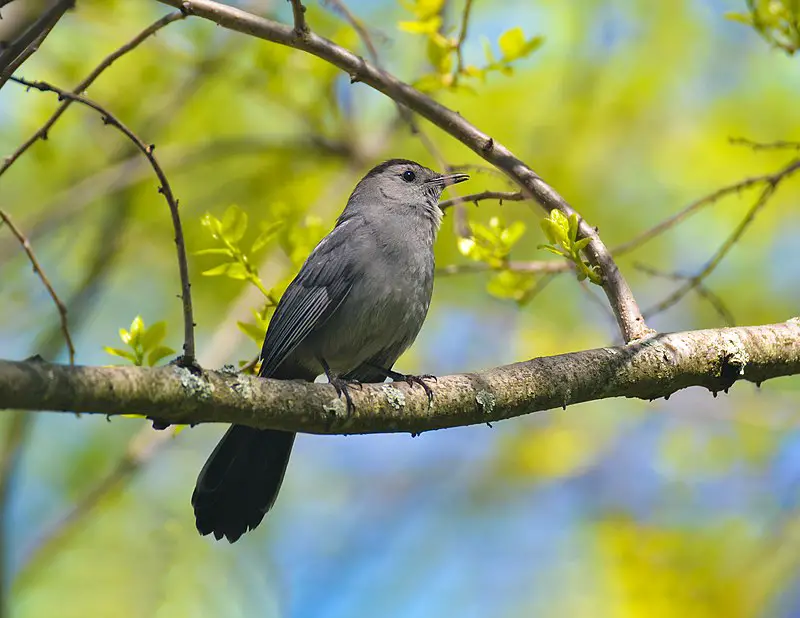
The Gray Catbird is a medium-sized bird native to North and Central America. It is the only species in its genus, Dumetella, which makes it unique among other perching birds of the Mimidae family.
Its plumage features shades of gray with some brownish tones on top and lighter grey below.
The underside of its tail has white feathers contrasting against their otherwise monochromatic coloration; this feature gives them their name as they often flick their tails when alarmed or excited as cats do.
They are omnivorous but mainly feed on insects such as caterpillars, grasshoppers, and beetles while eating fruits like berries or cherries during summer.
Despite being commonly seen alone or in pairs, these birds will flock together at times for protection from predators like hawks, who are drawn to their dark coloration against green foliage, making them harder to spot.
Scientific classification:
| Kingdom | Animalia |
| Phylum | Chordata |
| Class | Aves |
| Order | Passeriformes |
| Family | Mimidae |
| Genus | Dumetella C.T. Wood, 1837 |
| Species | D. carolinensis |
Also Featured In: Gray Birds that You’ll Find in Minnesota, Birds that Live in Manitoba
22. Cuckoos
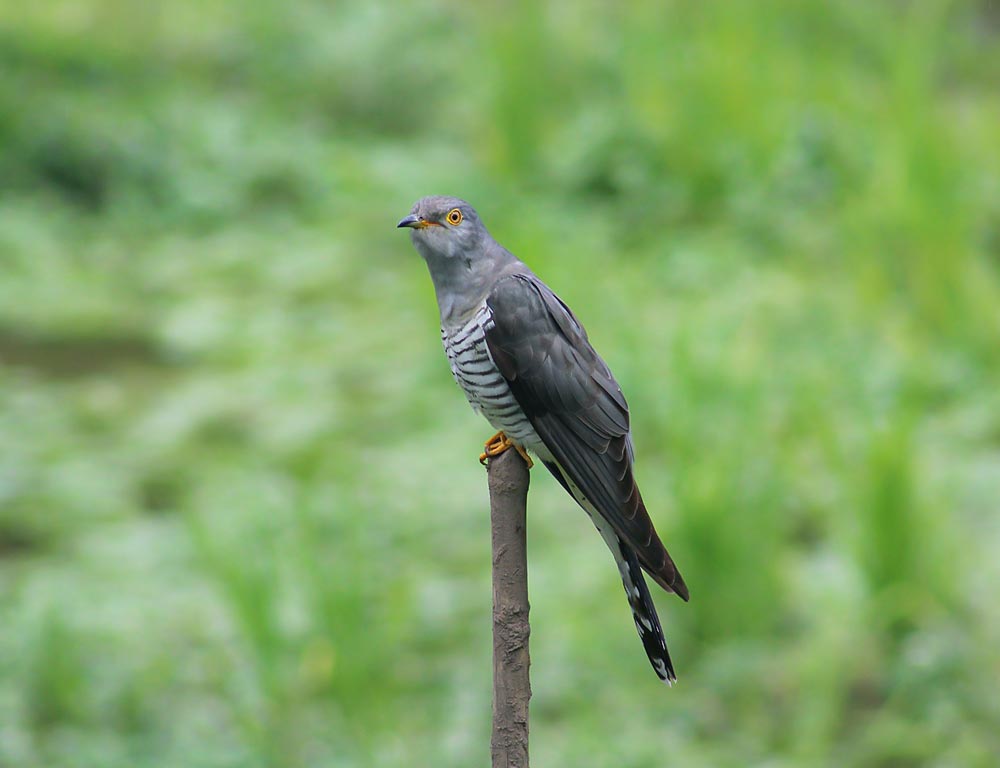
Cuckoos are fascinating birds belonging to the Cuculidae family, which is the only taxon in the order Cuculiformes.
This family has many different species, such as common or European cuckoo, roadrunners, koels, malkohas, couas, and anis.
Some of these species may even be identified as separate families – Centropodidae and Crotophagidae, respectively.
These birds have been known for their unique features, such as loud calls heard consistently during certain times of day and night.
They also exhibit behavior like brood parasitism, where they lay eggs in other nests so that their chicks can get more food from host parents than their own.
All these traits make them one-of-a-kind creatures worth admiring.
Scientific classification:
| Kingdom | Animalia |
| Phylum | Chordata |
| Class | Aves |
| Clade | Otidimorphae |
| Order | Cuculiformes Wagler, 1830 |
| Family | Cuculidae Leach, 1820 |
Also Featured In: Most Common Types of Bangladeshi Birds, Birds of Sweden
23. Broad-Billed Hummingbird
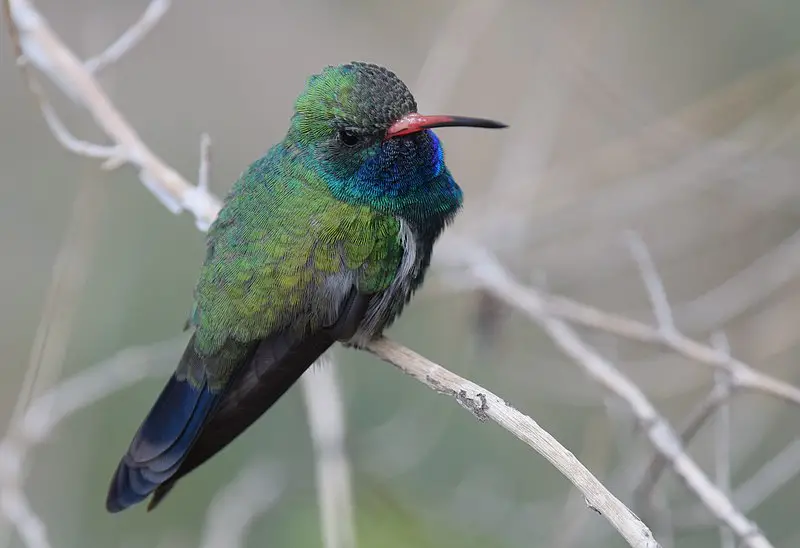
The Broad-billed Hummingbird is a small species of hummingbird that can be found in Mexico and the southwestern United States.
It has distinctive sexual dimorphism, with females resembling their juvenile counterparts more than males do.
This bird stands out thanks to its bright colors and broad, red bill. Other common names for this species include Colibri Mexicano (Spanish) or Mexican Hummingbird.
The Broad-billed usually nests on trees or shrubs near streams but may also occupy wooded areas or gardens close to human settlements during wintertime.
They feed mainly on nectar from flowers while supplementing their diet with insects depending on the availability of prey items and seasonal changes throughout their range area.
Scientific classification:
| Kingdom | Animalia |
| Phylum | Chordata |
| Class | Aves |
| Order | Apodiformes |
| Family | Trochilidae |
| Genus | Cynanthus |
| Species | C. latirostris |
Also Featured In: Top Birds Found in Mexico, Puerto Vallarta Birds You Should Know
24. Swallows
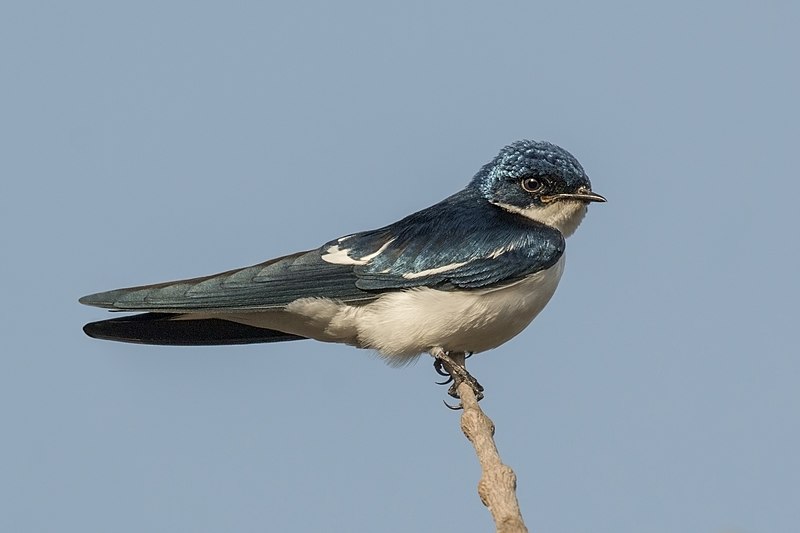
Swallows are small songbirds found worldwide on all continents, even Antarctica. They have a distinctive appearance and are highly adapted to aerial feeding with their long wings and forked tails.
There are an estimated 90 species of swallows in 19 different genera, making them one of the most widespread bird families on earth.
The barn swallow is perhaps the most well-known species among these birds due to its presence near human settlements across Europe; they’re so ubiquitous that “swallow” has become synonymous with this particular type of bird there.
Swallows also play important roles in ecology as insectivores, some species migrating vast distances yearly between summer breeding grounds and wintering locations.
Scientific classification:
| Kingdom | Animalia |
| Phylum | Chordata |
| Class | Aves |
| Order | Passeriformes |
| Suborder | Passeri |
| Family | Hirundinidae Rafinesque, 1815 |
Also Featured In: Birds of United Kingdom, Most Common Romanian Birds
25. Great Blue Heron
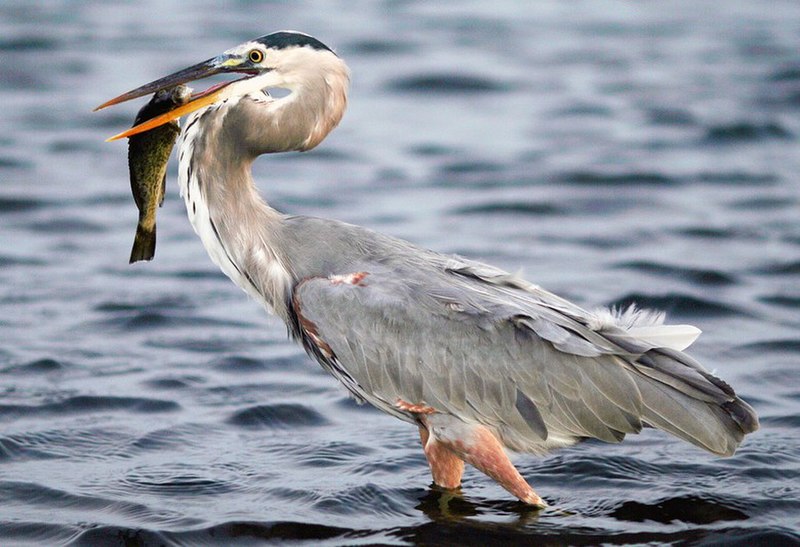
The Great Blue Heron is a majestic wading bird found in many parts of North America, Central America, the Caribbean, and even as far away as the Galapagos Islands.
It has an impressive wingspan which can reach up to six feet wide. Its feathers are mainly bluish-gray with brownish streaks on both its neck and chest, while its head displays white plumes. The adult herons can also be identified by their yellow bill and legs.
They live near bodies of water such as lakes, marshes, or rivers, feeding on fish using a spear-like motion with their sharp bills. An all-white population exists only in South Florida and the Florida Keys, making it quite unique.
Scientific classification:
| Kingdom | Animalia |
| Phylum | Chordata |
| Class | Aves |
| Order | Pelecaniformes |
| Family | Ardeidae |
| Genus | Ardea |
| Species | A. herodias |
Also Featured In: Common Birds in Canada, Flight Birds You Should Know
26. Pileated Woodpecker
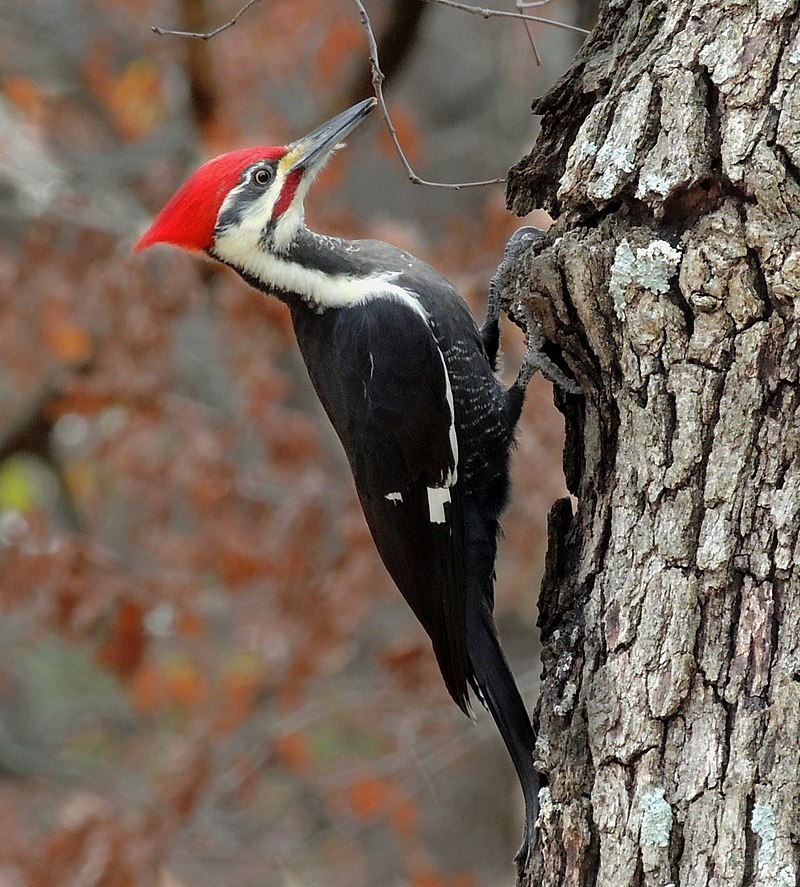
The pileated woodpecker is a large, majestic bird native to North America.
Its striking black plumage and red crest make it an unmistakable sight in the forest canopy of deciduous forests across eastern North America, the Great Lakes region, Canada’s boreal forests, and parts of the Pacific Coast.
It is one of the largest woodpeckers in North America: larger than any other confirmed species except for perhaps its relative, the ivory-billed woodpecker.
Insectivorous by nature, this stunning creature can be seen pecking away at tree trunks, searching for food, or making nest cavities – all with remarkable skill.
The pileated woodpecker truly stands out as a symbol of beauty and resilience amongst our avian wildlife.
Scientific classification:
| Kingdom | Animalia |
| Phylum | Chordata |
| Class | Aves |
| Order | Piciformes |
| Family | Picidae |
| Genus | Dryocopus |
| Species | D. pileatus |
Also Featured In: Birds You’ll Find in Vancouver Island, Red Birds You’ll See in Oklahoma
27. Piping Plover
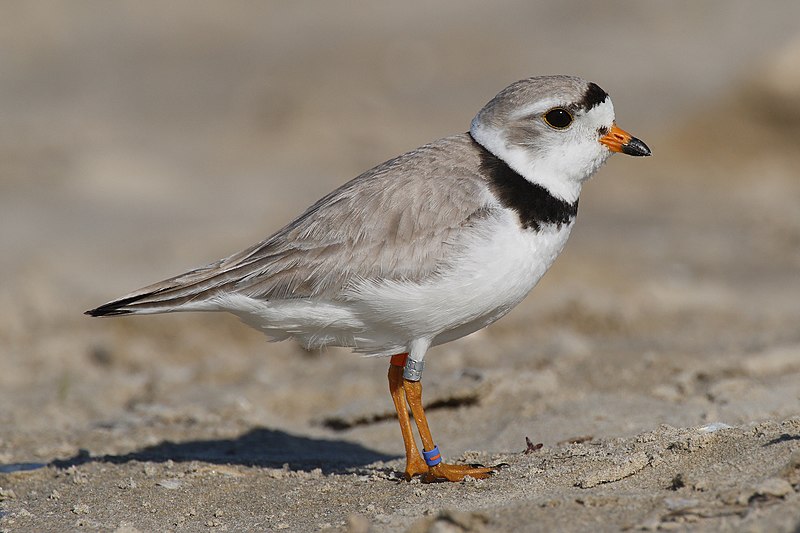
The Piping Plover is a small shorebird that can be found along sandy or gravel beaches in North America.
It has yellow-orange-red legs, and its distinctive features include a black band across the forehead from eye to eye and a thicker chest band for males during the breeding season.
They are threatened by human activity in their habitats, such as the increasing development of coastal areas and the destruction of their nesting sites due to recreation activities like beach driving and off-leash dogs.
Conservation efforts aim to protect these birds through habitat protection measures, including fencing off areas where they nest and restricting access during breeding seasons.
The future looks brighter with conservation initiatives by local governments slowly bringing the population up again over time.
Scientific classification:
| Kingdom | Animalia |
| Phylum | Chordata |
| Class | Aves |
| Order | Charadriiformes |
| Family | Charadriidae |
| Genus | Charadrius |
| Species | C. melodus |
Also Featured In: Birds that can be Seen in Outer Banks, Large Birds of Michigan
28. Sandhill Crane
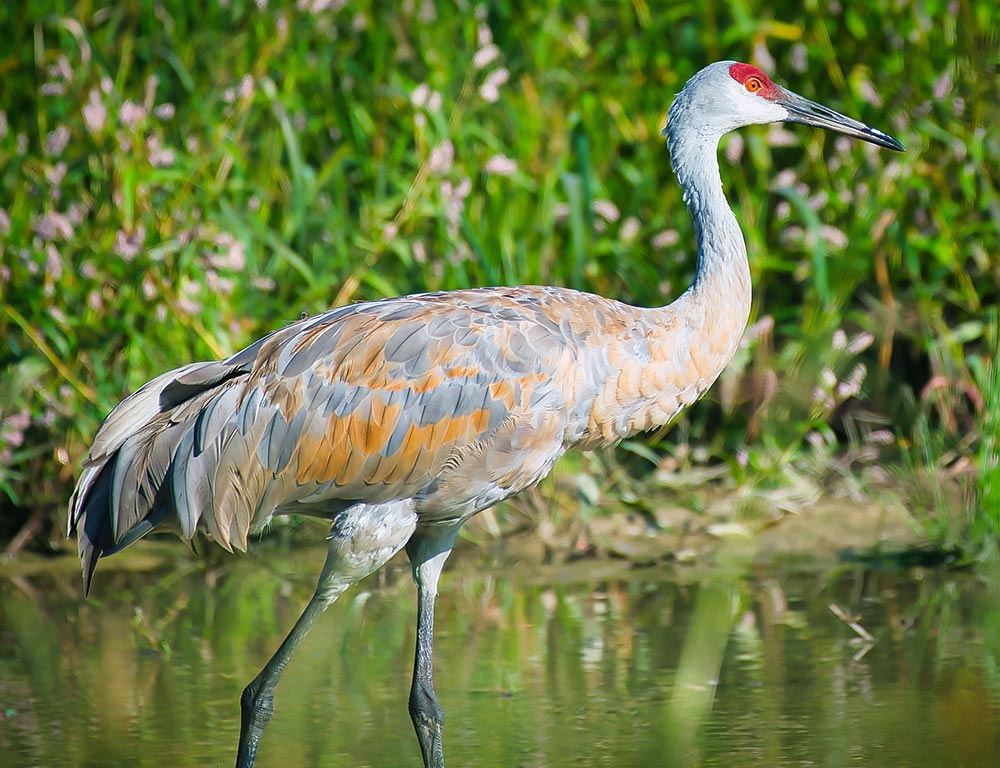
Sandhill Cranes are a large crane species native to North America and northeastern Siberia. They are known for their distinctive calls, long legs, and long necks.
These birds typically inhabit wetland areas like the Platte River in Nebraska’s Sandhills on the Great Plains.
In Central Florida, they often gather at the edges of bodies of water such as lakes or rivers.
During the breeding season, sandhill cranes can be seen performing elaborate courtship dances that involve bowing and jumping in unison with their partner.
Their diet consists mainly of plant material, including grains, roots, tubers, and aquatic plants, which they obtain by pecking or digging into mudflats using their bill or feet.
With an average lifespan of 10-20 years, these majestic creatures greatly add to any wetland habitat.
Scientific classification:
| Kingdom | Animalia |
| Phylum | Chordata |
| Class | Aves |
| Order | Gruiformes |
| Family | Gruidae |
| Genus | Antigone |
| Species | A. canadensis |
Also Featured In: Most Common Types of Birds Found in Cuba, Swamps Birds You Should Know
29. Blue Grosbeak
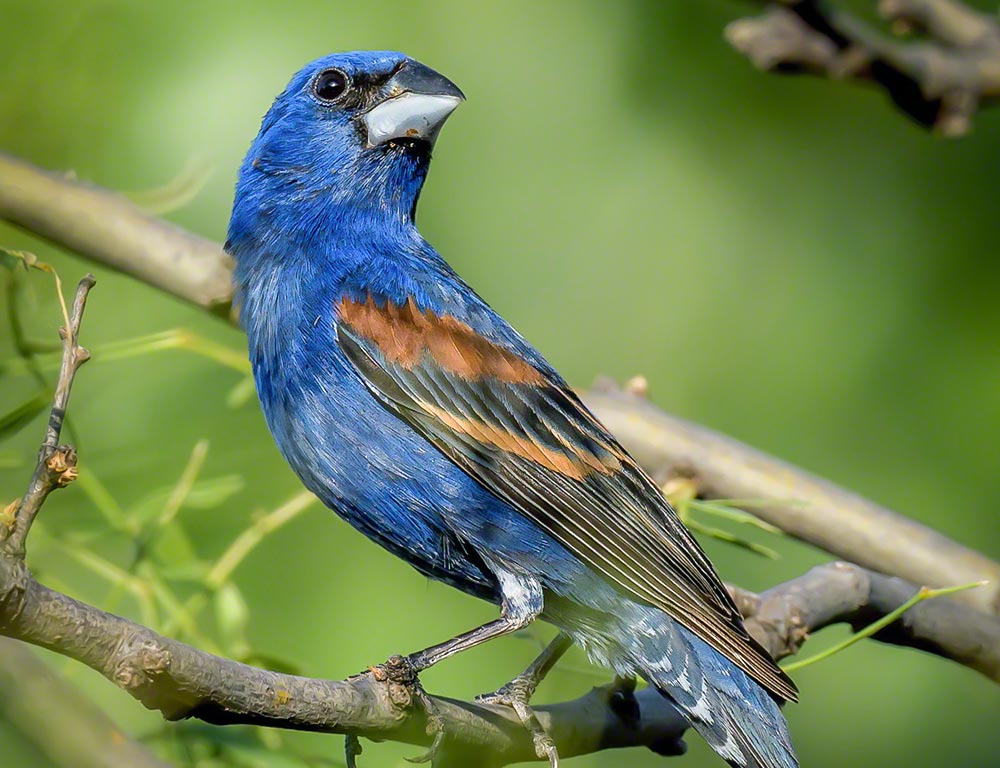
The Blue Grosbeak is a medium-sized North American passerine bird from the Cardinalidae family. It has striking plumage, with males showing off an impressive blue coloration and two brown wing bars.
Females are mainly brown with scattered blue feathers on the upperparts, but they also have two brown wing bars like males do.
During summer months, these birds can be found in northern Mexico and the southern United States, where they breed, while during wintertime, they migrate to Central America for resting purposes.
This beautiful species of bird is easy to spot due to its vibrant colors, making it a popular sight amongst wildlife observers.
Scientific classification:
| Kingdom | Animalia |
| Phylum | Chordata |
| Class | Aves |
| Order | Passeriformes |
| Family | Cardinalidae |
| Genus | Passerina |
| Species | P. caerulea |
Also Featured In: El Salvador Birds, Spring Birds that Live around Us
30. Ruby-Throated Hummingbird
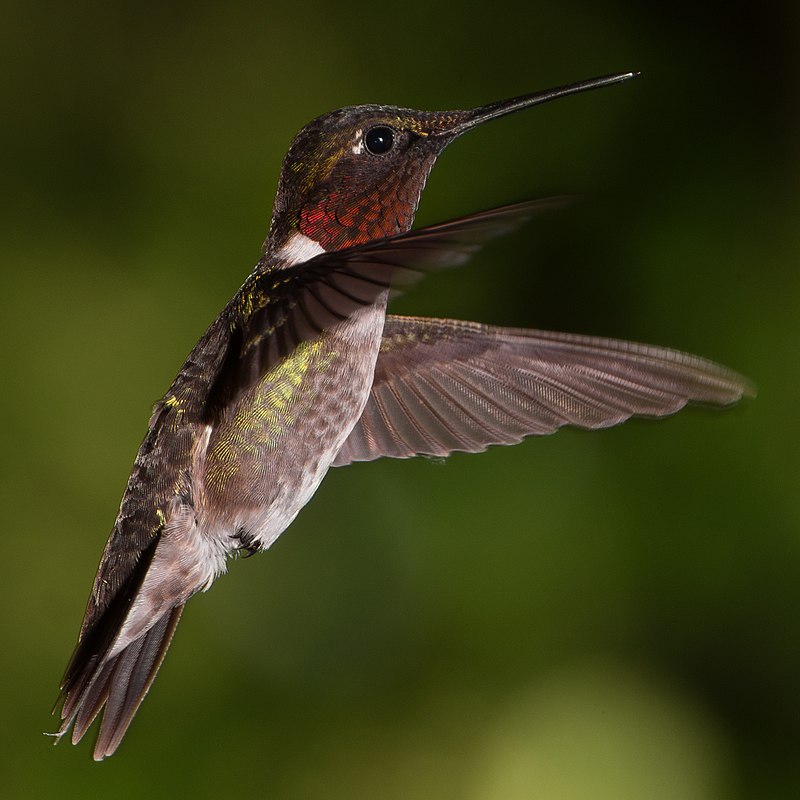
The ruby-throated hummingbird (Archilochus colubris) is a hummingbird species with an impressive migration pattern, spending the winter in Central America, Mexico, and Florida before flying to Canada and other parts of Eastern North America for the breeding season.
It’s by far the most common type seen east of the Mississippi River in North America.
Formally described by Swedish naturalist Carl Linnaeus in 1758, this tiny bird has bright metallic green upperparts with white underparts, a small black bill, and a red throat patch, which gives it its name; they measure around 3 inches long on average.
They feed primarily on nectar from flowers but also eat insects such as flies or mosquitoes for extra protein during their migrations or when raising young chicks.
Scientific classification:
| Kingdom | Animalia |
| Phylum | Chordata |
| Class | Aves |
| Order | Apodiformes |
| Family | Trochilidae |
| Genus | Archilochus |
| Species | A. colubris |
Also Featured In: Georgia Birds, Common Birds of Houston
31. Indigo Bunting
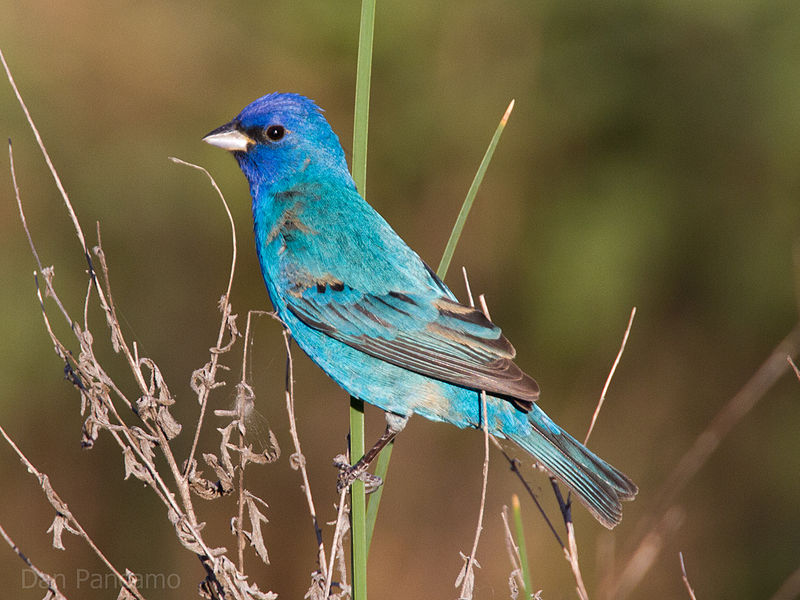
The Indigo Bunting is a small bird in the cardinal family throughout North and South America.
It has an unmistakable bright blue plumage that stands out against its natural habitat of farmland, brush areas, and open woodland.
During breeding season, it can be seen from southern Canada to northern Florida, while during winter months, it migrates south towards Central and Northern South America.
The Indigo Bunting prefers to migrate at night using the stars as navigation aids. This species feeds on insects and seeds which they find near the ground or catch mid-flight with their agile wingspan.
An iconic sight for many farmers across both continents, these birds are a welcome addition to any backyard oasis or wildflower meadow.
Scientific classification:
| Kingdom | Animalia |
| Phylum | Chordata |
| Class | Aves |
| Order | Passeriformes |
| Family | Cardinalidae |
| Genus | Passerina |
| Species | P. cyanea |
Also Featured In: Small Birds that Commonly Found in Ohio, Small Birds of Pennsylvania
32. Scarlet Tanager
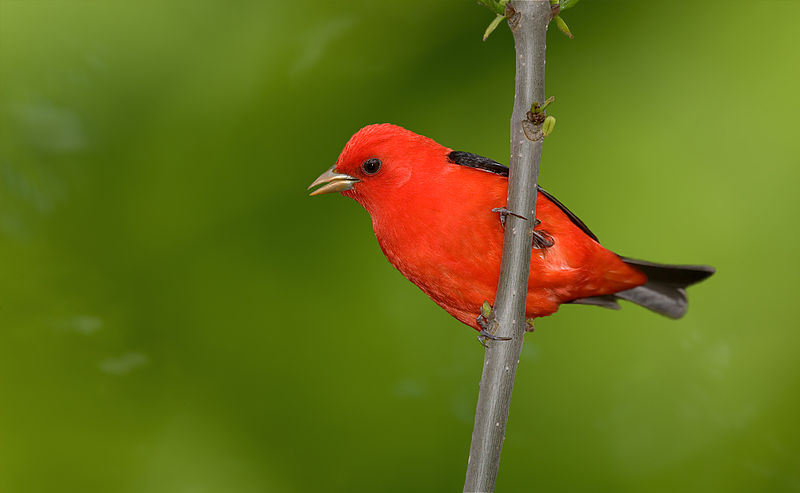
The Scarlet Tanager is a beautiful medium-sized bird in North and South America. It belongs to the Cardinal family and has striking red plumage with black wings and tail feathers.
Its song is similar to other cardinals yet also unique in its own way – it’s recognizable by its high whistles that become lower towards the end.
The species feeds mainly on insects and berries from trees or shrubs during the breeding season, when they may form loose flocks over open woodlands foraging for food.
They are highly territorial birds during nesting season, which happens between April and June; males and females fiercely defend their nests against intruders such as cats or squirrels.
Scientific classification:
| Kingdom | Animalia |
| Phylum | Chordata |
| Class | Aves |
| Order | Passeriformes |
| Family | Cardinalidae |
| Genus | Piranga |
| Species | P. olivacea |
Also Featured In: Yellow Connecticut Birds, Common Yellow Birds of Idaho
33. Royal Tern
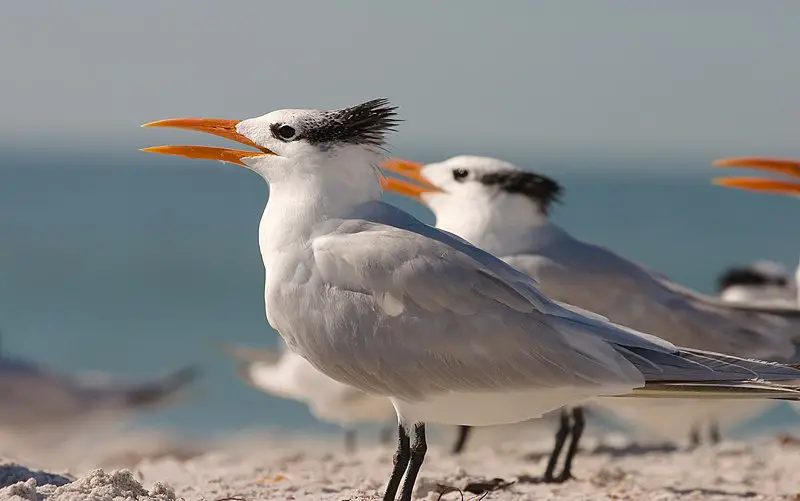
The Royal Tern is a beautiful seabird endemic to the Americas. It has been spotted as far away as Europe on rare occasions.
The species was first described by Georges-Louis Leclerc in 1781 from a specimen found in French Guiana and later illustrated with hand-colored plates.
These birds have elaborate courtship displays that involve loud vocalizations and energetic aerial acrobatics.
They typically mate for life, nesting together near marshes or beaches each season close to their food source of fish and other small aquatic creatures. Their white plumage brightens up coastlines across America – they are truly majestic.
Scientific classification:
| Kingdom | Animalia |
| Phylum | Chordata |
| Class | Aves |
| Order | Charadriiformes |
| Family | Laridae |
| Genus | Thalasseus |
| Species | T. maximus |
Also Featured In: Uruguay birds, Caribbean Birds
34. House Wren
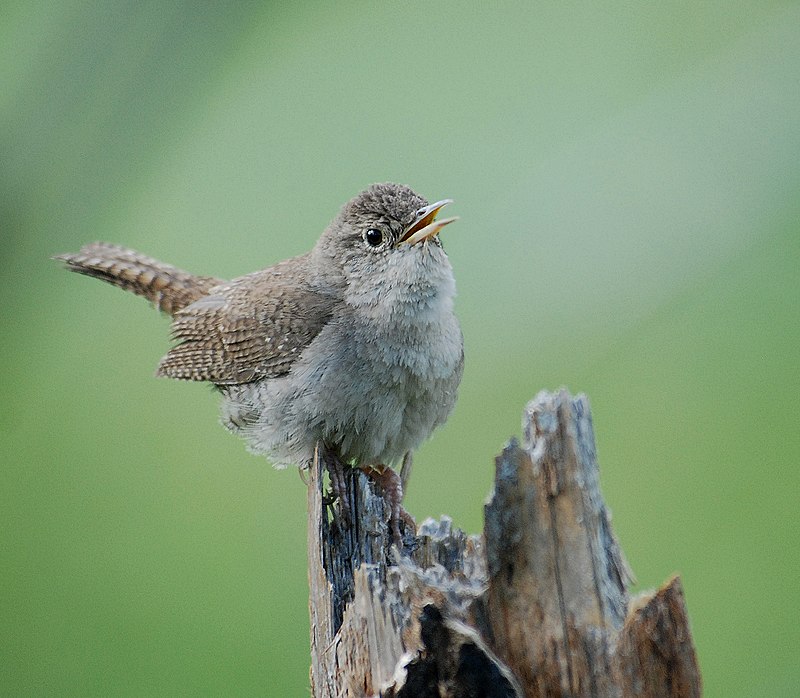
The House Wren is a small bird of the Wren family found in Canada and South America. It’s quite common in suburban areas and is one of the most widely distributed native birds in North and South America.
Its taxonomy can be complicated, with some subspecies groups considered separate species.
The House Wren has a brown back, grey head, white eyebrow stripes, light chestnut belly, and buffy flanks.
They often inhabit old or abandoned buildings and shrublands near fields or open woods for nesting sites.
During breeding season, they are highly territorial, so make sure you create an inviting environment if you wish to invite them into your yard.
Scientific classification:
| Kingdom | Animalia |
| Phylum | Chordata |
| Class | Aves |
| Order | Passeriformes |
| Family | Troglodytidae |
| Genus | Troglodytes |
| Species | T. aedon |
Also Featured In: Suriname birds, Birds that Live around Central Florida
35. Blue-Gray Gnatcatcher
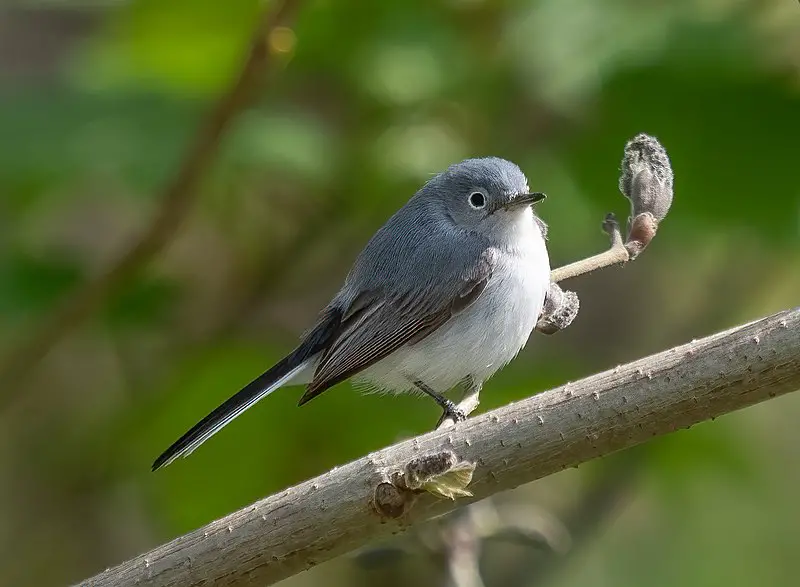
The Blue-gray Gnatcatcher is a beautiful small songbird native to North America. It has a length of 10–13 cm (3.9–5.1 in), a wingspan of 6.3 in (16 cm), and weighs only 5–7 g (0.18–0.25 oz).
Males have blue-gray upperparts with white underparts, slender dark bills, and long black tails edged in white; females are less vibrant but still eye-catching.
Juveniles are brownish-gray overall but may show some hints of adult coloration around their tails or shoulders as they mature into adulthood.
Their diet consists mainly of insects, which they catch while flitting through the air like tiny darts.
This stunning species can be found anywhere from woodlands to urban parks, so keep your eyes peeled for these delightful creatures on your next outdoor adventure.
Scientific classification:
| Kingdom | Animalia |
| Phylum | Chordata |
| Class | Aves |
| Order | Passeriformes |
| Family | Polioptilidae |
| Genus | Polioptila |
| Species | P. caerulea |
Also Featured In: Chickadees Birds, Birds That Live in Colorado
36. Scissor-Tailed Flycatcher
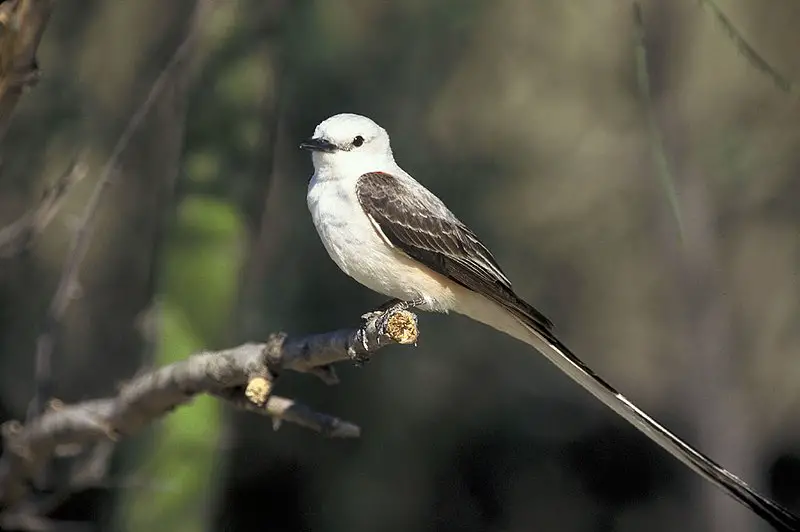
The scissor-tailed flycatcher is a beautiful bird belonging to the Tyrannus genus of kingbirds. It is known by various names such as Texas Bird-of-Parise and Swallow-Tailed Flycatcher.
This insectivorous bird has an impressive long tail, which it uses for courtship displays and aerial acrobatics – making it quite the showstopper.
Its range includes North America and Central South American regions where they breed in open fields, pastures, or grasslands with scattered trees available.
They feed on insects like dragonflies, damselflies, and small moths that they catch while gracefully gliding through the air with their wings spread apart wide.
To watch this amazing creature soar freely over its habitat would be nothing short of breathtaking.
Scientific classification:
| Kingdom | Animalia |
| Phylum | Chordata |
| Class | Aves |
| Order | Passeriformes |
| Family | Tyrannidae |
| Genus | Tyrannus |
| Species | T. forficatus |
Also Featured In: Flycatchers Species, Birds You’ll Find in South Texas
37. Western Kingbird
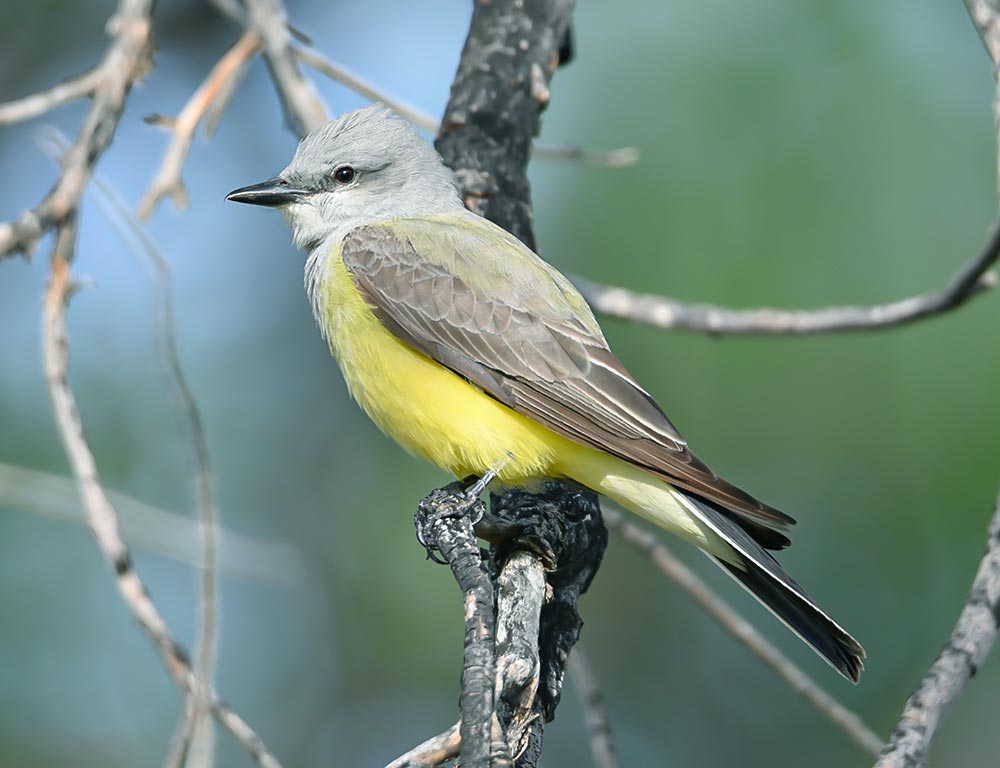
The Western kingbird is a large tyrant flycatcher native to western North America. It has striking plumage, with gray and yellow feathers tinged with crimson during courtship or when defending territory from intruders.
As is characteristic of its kind, the Western Kingbird exhibits highly territorial behavior towards other birds in its area.
They are found as far south as Mexico, inhabiting open habitats near bodies of water such as rivers and lakes.
While their primary diet consists of insects like bees and flies that they catch mid-flight, it also includes fruit for variety during winter months.
The species have recently seen an increase in population due to conservation efforts that aim to protect these beautiful creatures.
Scientific classification:
| Kingdom | Animalia |
| Phylum | Chordata |
| Class | Aves |
| Order | Passeriformes |
| Family | Tyrannidae |
| Genus | Tyrannus |
| Species | T. verticalis |
Also Featured In: Birds that Live in the Deserts, Common Southern Californian Birds
38. Black-And-White Warbler
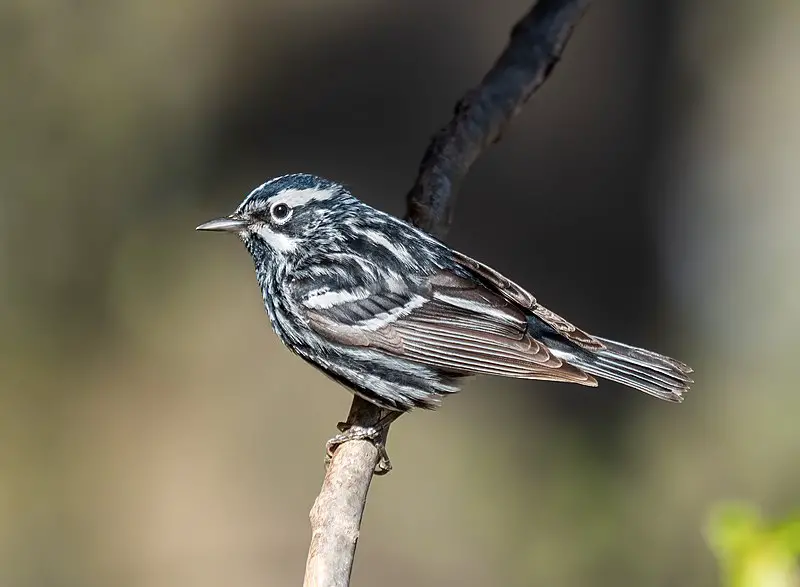
The Black-and-white Warbler is a unique species of bird native to North America. It has striking black and white plumage and breeds in the northern part of the continent, wintering in Central America, Florida, the West Indies, and Peru.
This warbler is rarely seen as far west as Europe, but it’s still being studied for its behavior and ecology.
Its diet consists mainly of insects, which it catches by clinging to trees like a woodpecker before quickly darting away again when prey appears.
The population size remains stable, although they are vulnerable to habitat loss due to deforestation or other human activities, so their conservation status should be monitored closely over time.
Scientific classification:
| Kingdom | Animalia |
| Phylum | Chordata |
| Class | Aves |
| Order | Passeriformes |
| Family | Parulidae |
| Genus | Mniotilta Vieillot, 1816 |
| Species | M. varia |
Also Featured In: Nuthatches Species, Long Island Birds You Should Know
39. Clay-Colored Sparrow
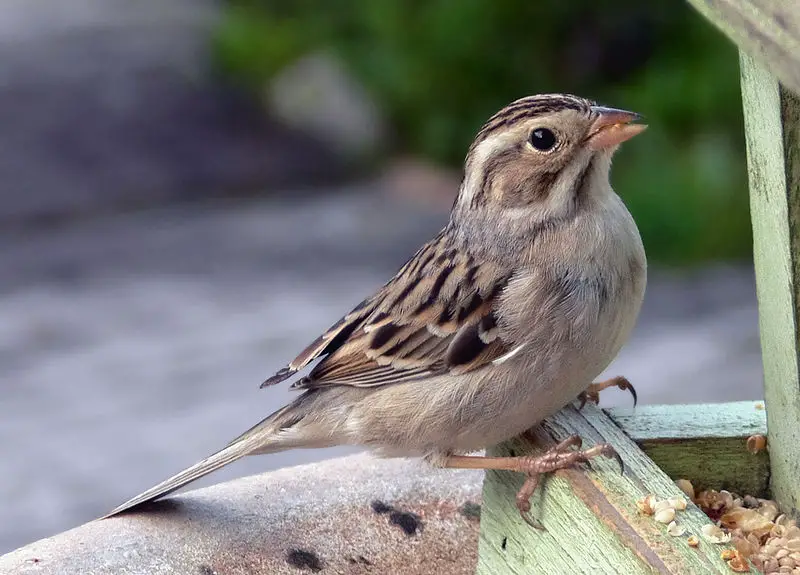
The Clay-colored sparrow is a small, light brown bird found in North America. It has pale underparts with darker streaks on its back and a white line above the eyes that contrasts against its dark crown.
Its wings have wing bars, and it also has a distinctive light brown cheek patch. Its short bill is typically pale in color, adding to its unique appearance.
This friendly little bird often feeds near houses or gardens where they can easily find food sources such as seeds and insects while making cheerful chirps and searching for sustenance.
They are an important part of the local ecosystem since they help keep insect numbers down, allowing farmers to harvest better without needing pesticides.
Scientific classification:
| Kingdom | Animalia |
| Phylum | Chordata |
| Class | Aves |
| Order | Passeriformes |
| Family | Passerellidae |
| Genus | Spizella |
| Species | S. pallida |
Also Featured In: Sparrows Species, Common Birds in Saskatchewan
40. Tree Swallow
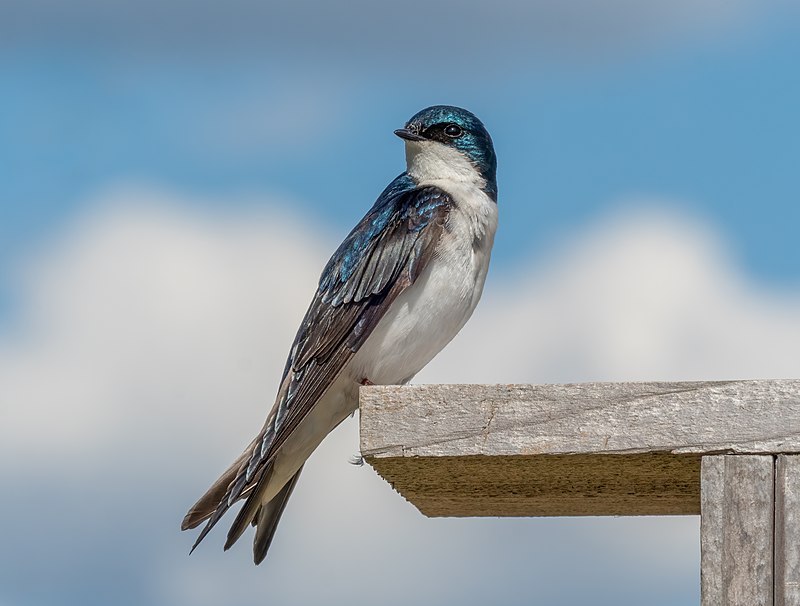
The Tree Swallow is a migratory bird of the Hirundinidae family, first described by French ornithologist Louis Vieillot in 1807. It has glossy blue-green upperparts and white underparts with iridescent violet on its throat and breast.
Its wings are blackish above with pale grey below, while its tail feathers are blackish-blue with white edges.
During the breeding season, they build cup-shaped nests out of grasses or twigs lined with animal hair or fur found near their nesting sites.
They feed mainly on insects such as flies and beetles that they catch while flying over fields or water surfaces during summer months when food is abundant for them to survive migration back southward in the wintertime.
The tree swallow is an important part of our environment both aesthetically and ecologically due to its insectivorous diet helping keep pest populations low in certain areas where agricultural crops may otherwise be damaged without these birds around.
Scientific classification:
| Kingdom | Animalia |
| Phylum | Chordata |
| Class | Aves |
| Order | Passeriformes |
| Family | Hirundinidae |
| Genus | Tachycineta |
| Species | T. bicolor |
Also Featured In: Swallows Species, Blue Birds You’ll Found around Us
41. California Scrub Jay
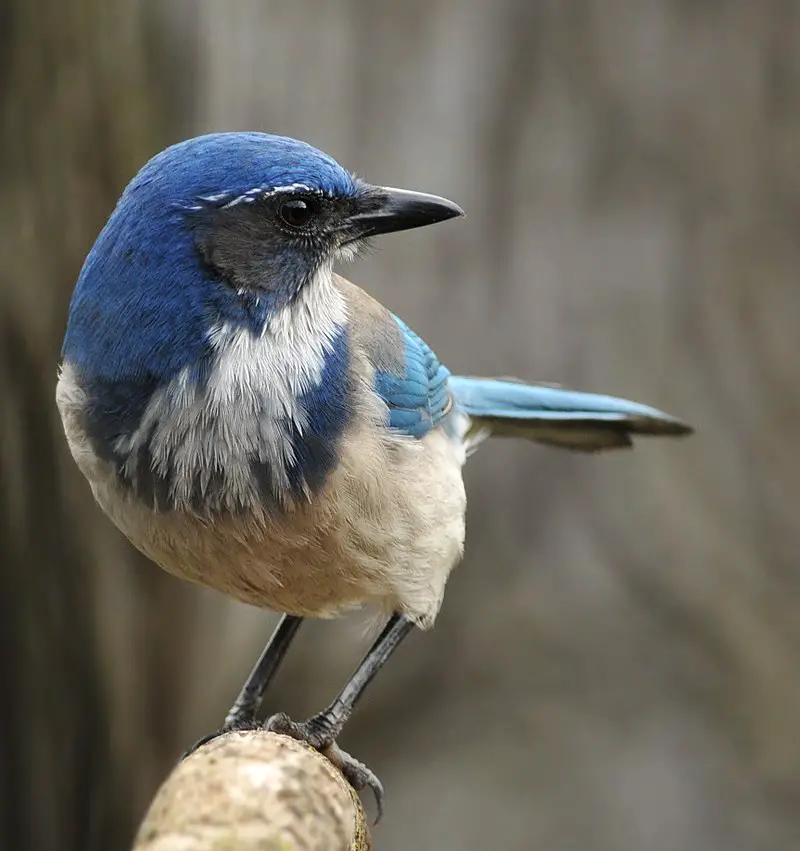
The California scrub jay is a bird species native to western North America. It can be found from southern British Columbia all the way down through California and western Nevada near Reno, up to the west beyond the Sierra Nevada range.
This beautiful blue feathered bird was once categorized with Woodhouse’s scrub jay as the “western scrub jay,” along with island scrub jays.
The California Scrub Jay has distinctive features such as its greyish-blue feathers on its head, wings, and tail; white cheeks; dark bill; and strong legs for perching in trees, which makes it stand out among other birds in its family.
Scientific classification:
| Kingdom | Animalia |
| Phylum | Chordata |
| Class | Aves |
| Order | Passeriformes |
| Family | Corvidae |
| Genus | Aphelocoma |
| Species | A. californica |
Also Featured In: Common Californian Birds, Birds Live Near San Diego
42. Painted Bunting
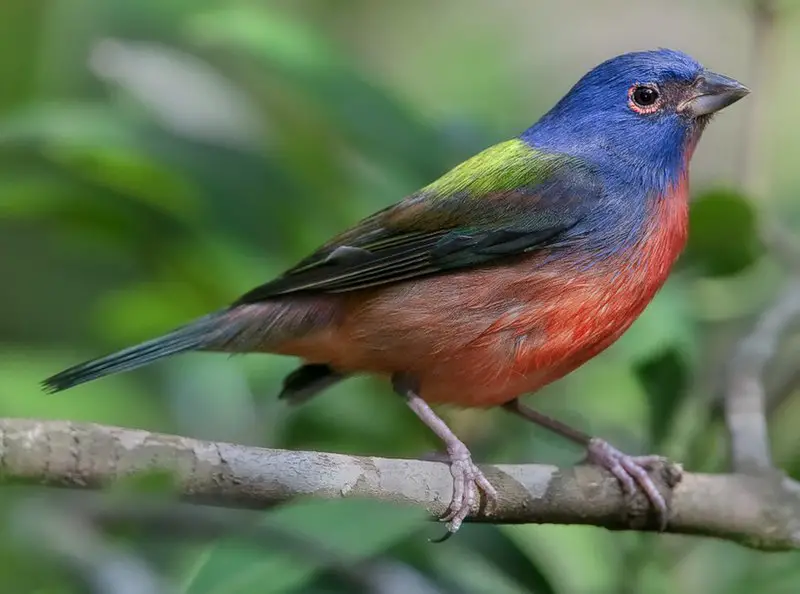
The Painted Bunting is an eye-catching bird from the Cardinal family, native to North America. It was first described by Carl Linnaeus in his eighteenth-century Systema Naturae.
The males of this species are particularly striking; they have brightly colored plumage, which only appears after their second year of life and can be distinguished from female birds through close inspection.
These colorful songbirds delight any avid birder, with their vibrant hues bringing joy to nature lovers everywhere.
They often inhabit woodland areas where plenty of seeds and insects are available for them to feed on – as well as some shrubbery so that they can hide away safely when needed.
Scientific classification:
| Kingdom | Animalia |
| Phylum | Chordata |
| Class | Aves |
| Order | Passeriformes |
| Family | Cardinalidae |
| Genus | Passerina |
| Species | P. ciris |
Also Featured In: Texas Birds, Flocks Birds around Us
43. Yellow-Headed Blackbird
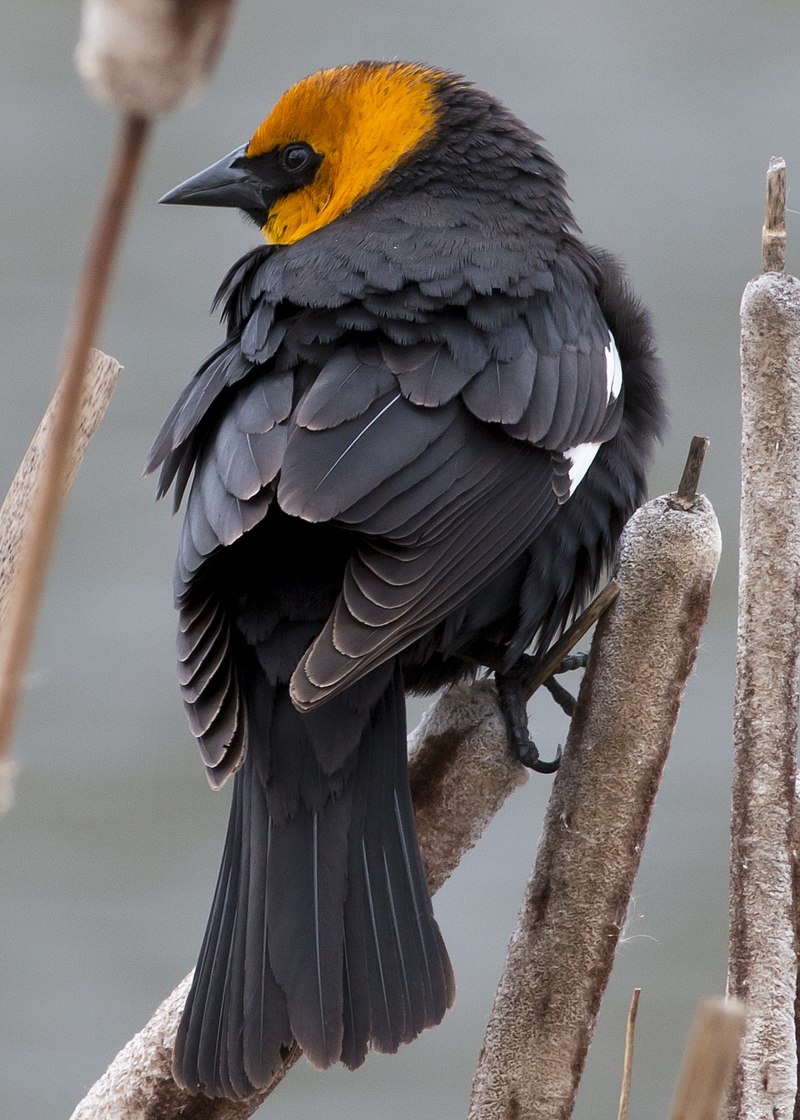
The yellow-headed blackbird is a medium-sized bird with striking features – its head and neck are bright yellow, while the rest of its body is black.
It has large eyes, a pointed bill, and long wings that help it soar through the air. The species gets its name from Greek words meaning ‘yellow’ (xanthous) and ‘head’ (cephalus).
This species can be found in wetlands across North America during summer months, where they feed on insects and other invertebrates such as snails, earthworms, spiders, and crustaceans.
During winter, they migrate southward for food or when temperatures drop too low for comfort.
They also form flocks, making them more visible than solitary birds like hawks or owls. Yellow-headed Blackbirds make beautiful sounds that echo around wetland areas; these melodic calls bring joy to many nature lovers.
Scientific classification:
| Kingdom | Animalia |
| Phylum | Chordata |
| Class | Aves |
| Order | Passeriformes |
| Family | Icteridae |
| Genus | Xanthocephalus Bonaparte, 1850 |
| Species | X. xanthocephalus |
Also Featured In: Utah Birds, Birds Live in Arkansas
44. Rose-Breasted Grosbeak
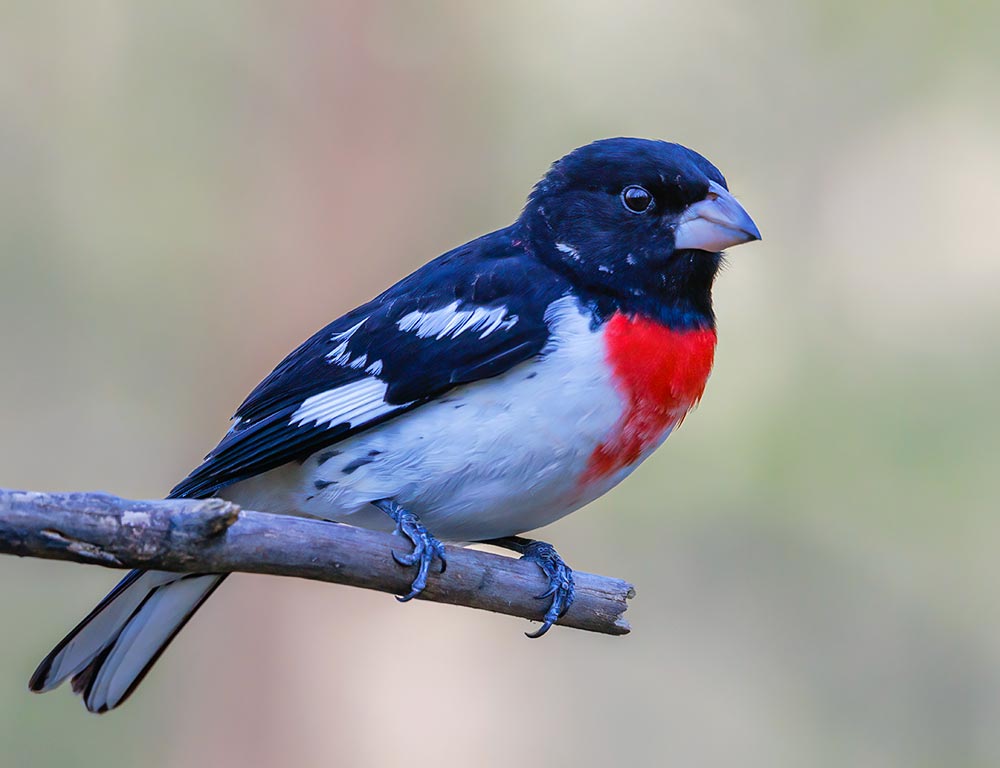
The Rose-breasted Grosbeak is a large, brightly colored bird belonging to the Cardinal family. Males have black heads and wings, with white breasts boasting a bright rose patch.
Females are more muted in color, mostly buffy brown or greyish overall, but still feature the distinctive rose breast patch. The two sexes also exhibit marked sexual dimorphism.
These birds inhabit open woodlands across North America, where they feed on seeds gleaned from foliage as well as fruits such as cherries and blueberries during their breeding season, which runs from April through August each year
.Scientific classification:
| Kingdom | Animalia |
| Phylum | Chordata |
| Class | Aves |
| Order | Passeriformes |
| Family | Cardinalidae |
| Genus | Pheucticus |
| Species | P. ludovicianus |
Also Featured In: Nebraska Birds, Most Common Songs Birds that Live around You
45. New World Orioles
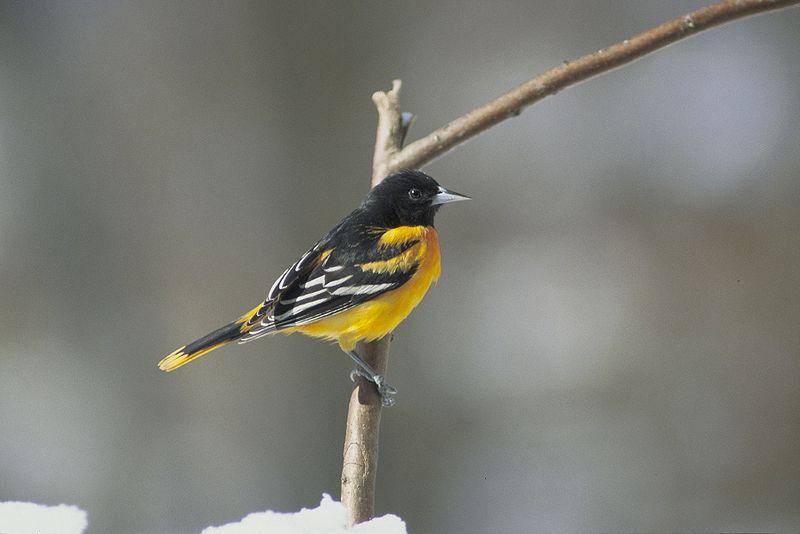
New World orioles are a group of birds belonging to the blackbird family. They share many features with Old World orioles, including size, diet, and behavior; however, they differ in their striking plumage.
Males have bright yellow or orange bodies with contrasting black wings and white markings on the head and breast.
Females and immature birds tend to be duller colors, such as browns and greys. These colorful songbirds feed primarily on fruit, insects, nectar from flowers, or sap from trees – sometimes even raiding other nests for eggs.
Their cheerful chirps can often be heard throughout parks during summertime months.
Scientific classification:
| Kingdom | Animalia |
| Phylum | Chordata |
| Class | Aves |
| Order | Passeriformes |
| Family | Icteridae |
| Genus | Icterus Brisson, 1760 |
Also Featured In: Louisiana Birds, Black And White Birds You Don’t Know About
46. Summer Tanager
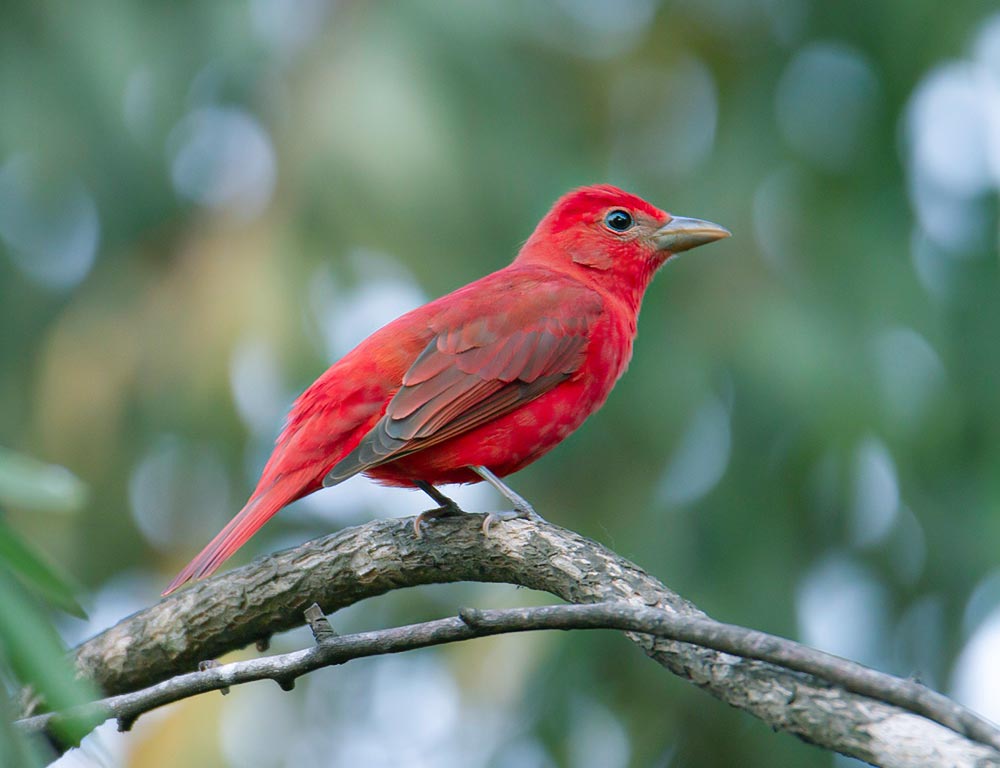
The Summer Tanager is a stunningly beautiful member of the cardinal family. Native to North and South America, this medium-sized songbird features striking red plumage on its back with yellow underparts.
It has a pointed black bill and long tail feathers that can be seen fluttering through the air when it flies.
The species’ vocalizations are quite similar to those of other members of its genus as well, which often include short whistles and chirps in addition to longer songs made up of various phrases or syllables.
With their vibrant colors and melodic voices, these birds make an eye-catching sight any time they appear.
Scientific classification:
| Kingdom | Animalia |
| Phylum | Chordata |
| Class | Aves |
| Order | Passeriformes |
| Family | Cardinalidae |
| Genus | Piranga |
| Species | P. rubra |
Also Featured In: birds of Arkansas, New Hampshire Birds You Should Know
47. Hepatic Tanager
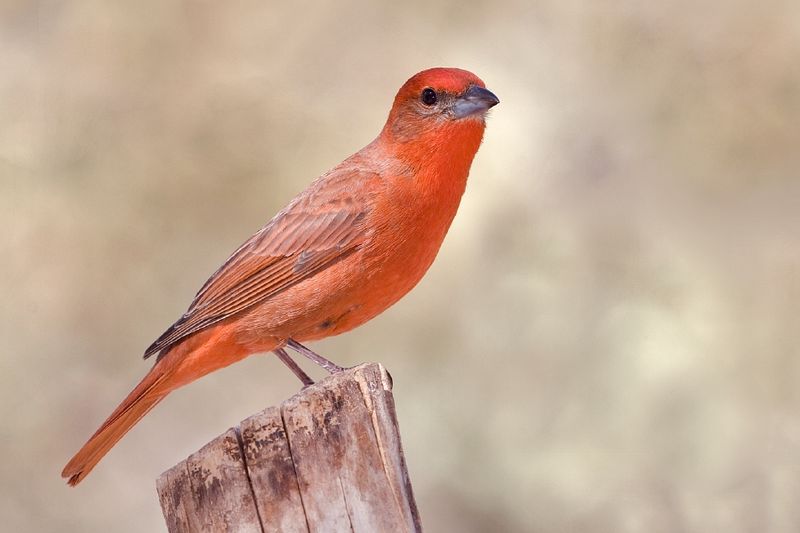
The Hepatic Tanager is a medium-sized bird found in North and South America. It has brownish-red plumage and belongs to the Cardinal family (Cardinalidae) of birds, formerly placed in the tanager family.
The species name, “flava,” comes from its liver-coloured feathers, which are quite striking when seen up close.
Its vocalizations also resemble that of other members of the cardinal family, making them easy to identify by sound. This bird feeds mainly on insects but also consumes some fruit and nectar too.
They typically live alone or with their mate but will gather together at times during migration season for protection against predators. All in all, this beautiful creature adds color and life to nature’s orchestra.
Scientific classification:
| Kingdom | Animalia |
| Phylum | Chordata |
| Class | Aves |
| Order | Passeriformes |
| Family | Cardinalidae |
| Genus | Piranga |
| Species | P. flava |
Also Featured In: Red Birds, Red birds You’ll See in Arizona
48. Northern Tanagers
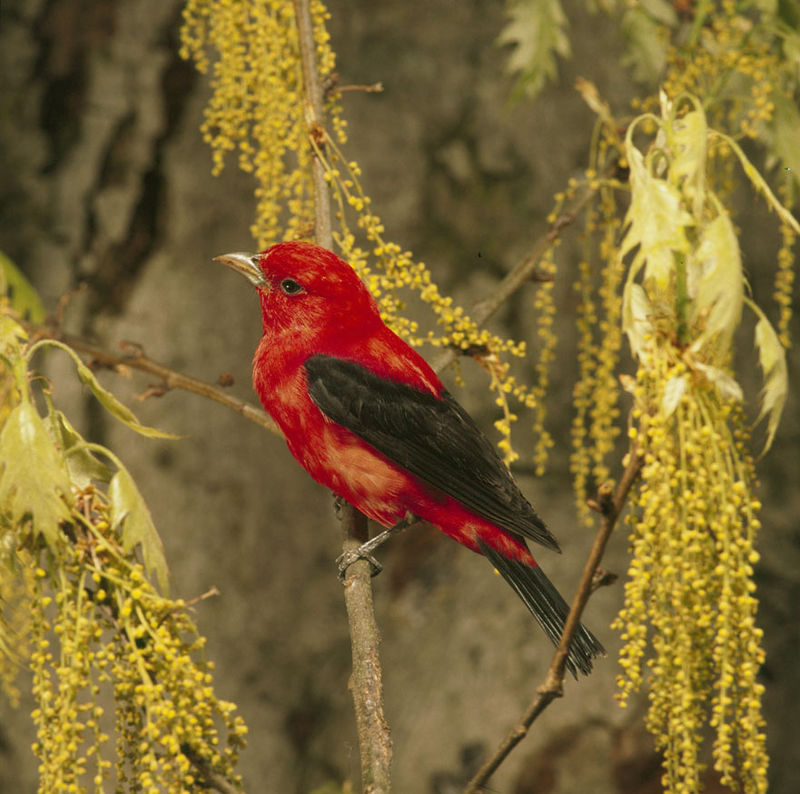
The Northern Tanager (Piranga horticola) is a bird species in the cardinal family. It has a distinctive red head and wings, with yellow to orange underparts and a black tail.
These birds can be found throughout much of North America, where they inhabit forests and woodlands during the breeding season before migrating south for winter months.
They feed on insects, nectar from flowers, fruits like berries and cherries, and small vertebrates like lizards or amphibians.
The male is particularly striking due to his bright colors; he sings often while perched atop trees to attract mates or defend territory against other males.
Female Northern Tanagers are duller but still have beautiful plumage that sets them apart from most other bird species.
Scientific classification:
| Kingdom | Animalia |
| Phylum | Chordata |
| Class | Aves |
| Order | Passeriformes |
| Family | Cardinalidae |
| Genus | Piranga Vieillot, 1808 |
49. Varied Bunting
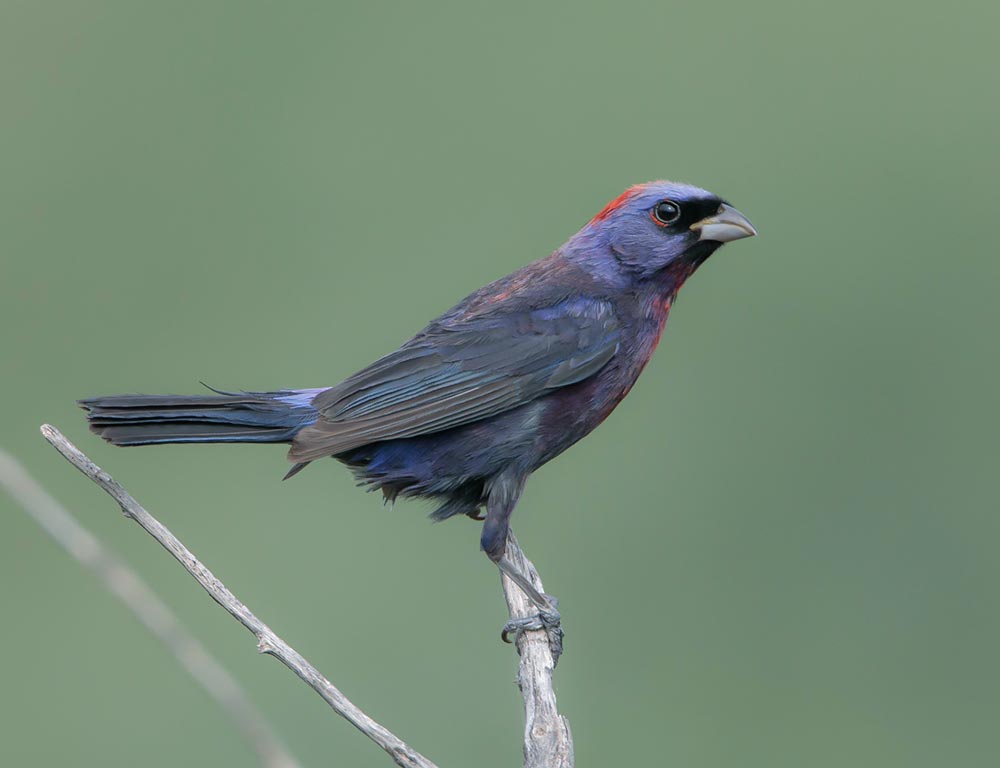
The Varied Bunting is a species of songbird belonging to the Cardinalidae family. It can be found in southern parts of Arizona, New Mexico, and Texas in the US, as well as throughout Mexico and into southeastern Guatemala.
This bird has a short tail, which makes it appear stocky, with its head and neck predominantly blue-grey or greyish brown, depending upon seasonal changes.
Its wings are black with white stripes on them, while its underside is yellow during summer months but turns orange for winter plumage.
Males have brightly colored heads consisting of blues, purples, and reds, which helps distinguish them from females who lack such bright colors instead of having shades closer to that seen on their backsides.
The varied bunting loves open woodlands – especially those near water sources like rivers – where they feed off insects and seeds; however, their diet also includes berries when available.
Scientific classification:
| Kingdom | Animalia |
| Phylum | Chordata |
| Class | Aves |
| Order | Passeriformes |
| Family | Cardinalidae |
| Genus | Passerina |
| Species | P. versicolor |
Also Featured In: birds of purple, Birds that Live in Morelos
50. Sandpiper
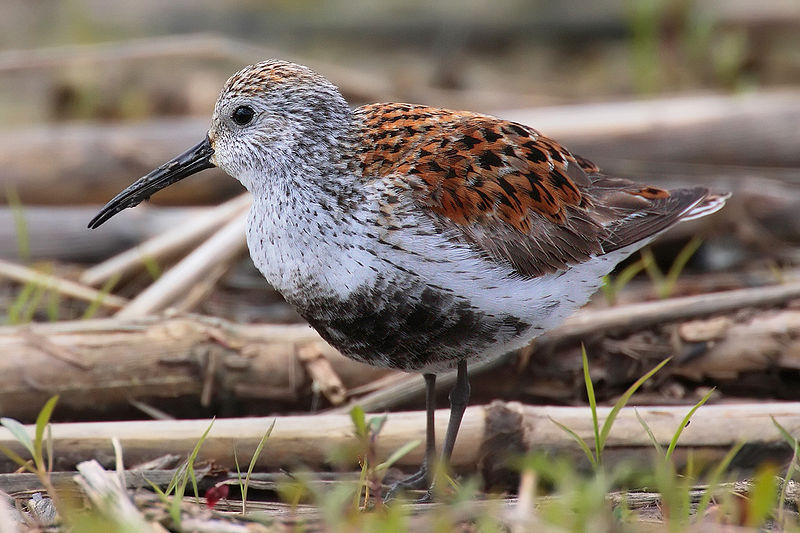
Sandpiper is a type of wading bird that belongs to the family Scolopacidae. It is a diverse family that includes various species, such as curlew and snipe.
Sandpipers have different bill lengths that allow them to feed on small invertebrates and creatures found in mud or soil.
Due to this diversity, different species can coexist in the same habitat without competing for food. Sandpipers are commonly found near the coast and in other wetland environments.
They are known for their slender legs, long beak, and streamlined body that enables them to move easily in and out of water.
Sandpipers are a unique and fascinating bird species that are interesting to observe in their natural habitat.
Scientific classification:
| Kingdom | Animalia |
| Phylum | Chordata |
| Class | Aves |
| Order | Charadriiformes |
| Suborder | Scolopaci |
| Family | Scolopacidae Rafinesque, 1815 |
Also Featured In: Birds You’ll Find in the Sea, Turkey Birds You Should Know
51. Cedar Waxwing
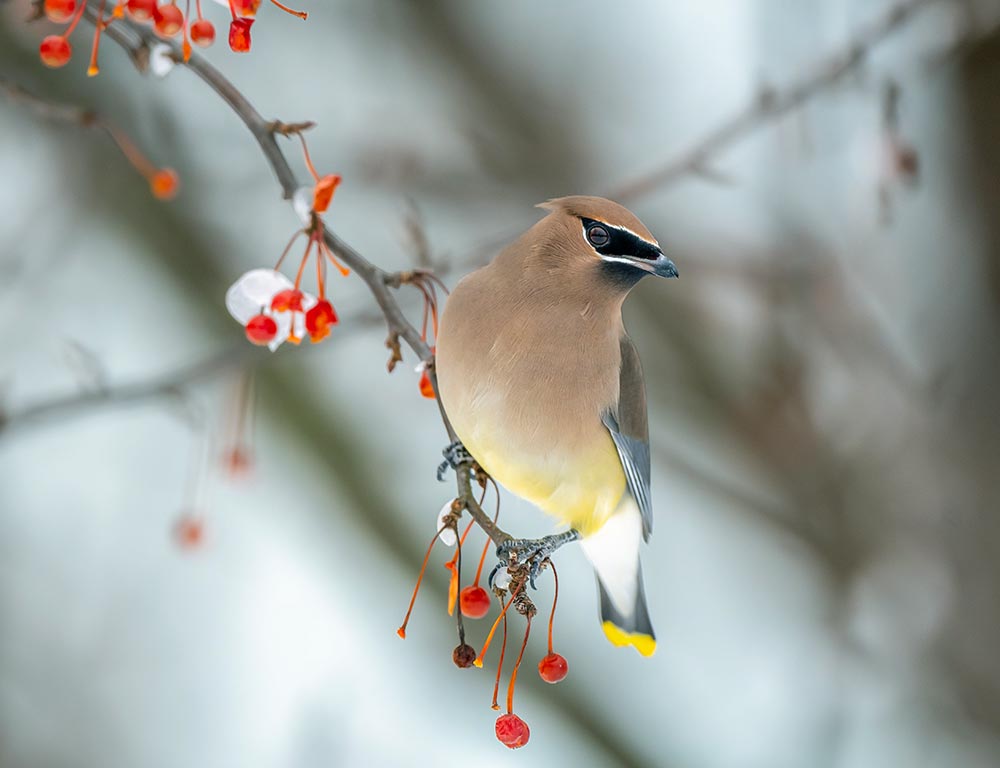
The Cedar waxwing, also known as Bombycilla cedrorum, is a medium-sized bird found in North and Central America.
Their body has a mixture of brown, gray, and yellow feathers, and their wings have wax-like tips.
These birds prefer open wooded areas in Southern Canada for breeding, and during winter, they migrate to the Southern part of the United States, Central America, and the far.
The Cedar waxwing is a member of the waxwing family of birds or Bombycillidae family. They are known for their distinctive crest on their head and a black mask-like area around their eyes.
These birds are social creatures and can often be seen in large flocks, sometimes even intermixing with other bird species.
Their diet consists mainly of fruit and insects, which are important fruit seed dispersers. The Cedar waxwing bird is a beautiful and fascinating creature to observe in the wild.
Scientific classification:
| Kingdom | Animalia |
| Phylum | Chordata |
| Class | Aves |
| Order | Passeriformes |
| Family | Bombycillidae |
| Genus | Bombycilla |
| Species | B. cedrorum |
Also Featured In: Birds Commonly Found in New York, Central Texas Birds
Conclusion
The 51 summer birds that grace our surroundings during the warmer months present a vibrant and diverse tapestry of avian life.
Each species, with its unique behaviors, calls, and plumage, contributes to the ecological balance and adds beauty to our natural landscapes.
Observing these birds not only offers us a chance to connect with nature but also serves as a reminder of the importance of environmental conservation.
As summer unfolds, these birds play crucial roles in pollination, pest control, and seed dispersal, demonstrating the interconnectedness of all life.
Their presence is a seasonal gift that enriches our environment and underscores the need to protect these magnificent creatures and their habitats for future generations to enjoy.